| | |
| Author | Message |
|---|
Meles meles
Censura
Posts : 5079
Join date : 2011-12-30
 |  Subject: Re: Dish of the Day - II Subject: Re: Dish of the Day - II  Sun 10 Nov 2019, 11:16 Sun 10 Nov 2019, 11:16 | |
| Missed this yesterday ... 9 November 1867 - the Tokugawa shogunate in Japan came to its official end when Tokugawa Yoshinobu, the 15th Tokugawa shogun, "put his prerogatives at the Emperor’s disposal" and then resigned 10 days later. Thus began the Meiji Restoration (明治維新 Meiji Ishin) when the 15 year-old emperor Meiji was restored as supreme ruler of Japan.   (left) The last shogun, Tokugawa Yoshinobu, circa 1860 - (right) the Emperor Meiji in 1873. The Tokugawa shoguns (hereditary military leaders) had ruled Japan since 1600 when Tokugawa Ieyasu seized control from the emperor. Emperors continued to exist thereafter but had no power. When most people think of 'typical' Japanese culture – arts, cuisine, samurai, geishas – they are actually more specifically thinking of the Tokugawa period. The culture had rigid codes of conduct and was strictly isolationist from other countries and foreign influence. But in the 1850s the intrusion of Western ships, notably Commodore Perry’s arrival in 1853, made it clear that isolationism had left Japan far behind the rest of the world in many spheres but particularly in technology. After considerable debate among the powerful there was some agreement, although it was far from universal, that the shoguns should relinquish power to the emperor, who would then open up Japan to modern influences. However the official end of the shogunate in November 1867 was not the end of the story. The samurai stood to lose, not just their old cultural ways, but their entire hereditary privilege which gave them power, wealth, and prestige. Accordingly in January 1868 the Boshin ("Year of the Earth Dragon") War broke out between imperial forces and those loyal to the ex-shogun. The two armies pursued each other around the whole length of Japan in a protracted series of battles and skirmishes, with both sides availing themselves, whenever possible, of Western-made modern rifles, machine-guns, artillery and steam warships (the British generally supported the Emperor while the French mostly supported the ex-Shogun's forces, but for both foreign powers it was profit that came first). However in the end it was the Imperial forces that prevailed to gain control over the entire country. The Meiji oligarchy that formed the government under the rule of the emperor first introduced measures to consolidate their power against the remnants of the Tokugawa period. In 1868 all Tokugawa lands were seized and placed under imperial control, thus placing them under the prerogative of the new Meiji government. In 1869 even the lands of daimyo (feudal lords) loyal to the emperor were taken away, and all the feudal domains were transformed into prefectures, whose governors were appointed by the emperor. Thus, arguably for the first time, there was a central government in Japan which exercised direct power through the entire realm. The new government then proceeded with unifying the country under a single, legitimate and powerful rule by the Imperial Court. The emperor's residence was officially transferred from Kyoto to Edo at the end of 1868 and Edo was then renamed, Tokyo. 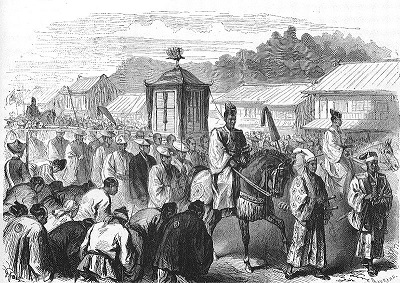 The Meiji Emperor relocating the imperial court and seat of government from Kyoto to Edo/Tokyo in 1868. To reform the military the government instituted nationwide conscription in 1873, mandating that every male would serve in the armed forces for four years upon turning eighteen; followed by three more years in the reserves. One of the primary differences between the samurai and peasant class was the right to bear arms, but now this ancient privilege was suddenly extended to every male in the nation. Furthermore samurai were no longer allowed to walk about town bearing a sword or weapon to show their status as in former times. This led to a series of riots from disgruntled samurai but they were swiftly put down by the newly formed Imperial Japanese Army - modelled on the French army, trained in Western tactics and equipped with modern weapons - even though the core of the new army was the Tokyo police force which was largely composed of former samurai. This sent a strong message to the dissenting samurai that their time was indeed over. However, it is equally true that the majority of samurai were content despite having their status abolished. Many found employment in the government bureaucracy, which resembled an elite class in its own right. The samurai, being better educated than most of the population, became teachers, gun makers, government officials, or military officers. While the formal title of samurai was abolished, the elitist spirit that characterized the samurai class lived on. Besides these drastic changes to the social structure of Japan, in an attempt to create a strong centralized state defining its national identity, the government established a dominant national dialect to replace local and regional dialects. This was based on language patterns of the Tokyo samurai classes and eventually become the norm in the realms of education, media, government and business. 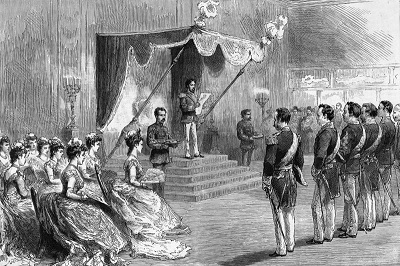 The promulgation of the new Japanese constitution in 1889. Note how none of the Japanese ladies wear kimonos but are all now dressed in the latest French fashions. As part of the Meiji reformations the Emperor also lifted the ban on eating red meat and promoted Western cuisine, which was widely viewed as the cause of the Westerner’s greater physical size. The style of cuisine known as yōshoku (洋食 - "western food") was thus created, and as a result of its origins, relies on meat as a common element, unlike the traditional Japanese cuisine at the time which was based on fish, and to a lesser extent poultry. Yōshoku cuisine remains popular in modern Japan, both for simple home cooking and in the common, informal pubs/bars known as izakayas. Many yōshoku dishes are barely distinguishable from Western counterparts with little more than a slight Japanese twist, while others show much more Japanese influence. For example omurice, (オムライス "omelette-rice") does resemble an omelet, but only just. It consists of fried rice wrapped in a very thin sheet of fried beaten egg and topped with American-style tomato ketchup. By contrast Nikujaga, (肉じゃが "meat-potato") is a sort of Irish stew with beef, onions and mushrooms, but in a sweet soy sauce and then served Japanese style with rice. So for today here's a recipe for nikujaga as an example of nineteenth century yōshoku, the form of Western/Japanese fusion cuisine that was deliberately introduced following the Meiji Restoration. Nikujaga itself was supposedly invented by chefs of the Imperial Japanese Navy in the late 19th century on the orders of Admiral Togo, to create a Japanese version of the beef stews then commonly served on British Royal Navy warships, which of necessity in the absence of refrigeration, were based on using salt-preserved beef or tinned 'bully-beef'. Togo had been in Britain from 1871 until 1878 studying naval science, technology, strategy and tactics, and in his orders to the Japanese navy chefs for the creation of nikujaga, he wasn't simply trying to ape RN practices, but was rather trying to address the very real problem of vitamin B deficiencies in naval diets that were based on preserved foods. Generally potatoes make up the bulk of the dish with the meat mostly serving as a source of flavor. Thinly sliced beef is the most common meat used although minced/ground beef is also popular, and because it is thinly sliced or minced nikujaga is not cooked for as long as a typical European beef stew. Shirataki are thin, transparent rice noodles. Dashi is the simmering stock of choice because it blends well with the soy. It is made from dried bonito flakes and kelp, and is the backbone of Japanese cooking, so it should usually be obtainable, at least in powdered form, from Asian grocers. Otherwise use beef stock but it should be thin and with no added salt. One important feature of this dish is that the vegetable pieces are big, much bigger than is usual in Western stews. Nikujaga is usually served accompanied by a bowl of plain white rice. Nikujaga. Ingredients: 1 tbsp vegetable oil 8 ounces beef sliced thin 1 onion, peeled and cut in thick slices 4 potatoes, peeled and cut into large chunks 1 carrot, peeled and cut into large pieces 4 fresh shiitake mushrooms, stems removed and quartered ½ cup sake 2 cups dashi or thin beef broth 2 tbsps sugar 3 tbsps soy sauce 5 oz bag shirataki noodles, drained and rinsed 3 ozs green beans, ends trimmed and left whole Instructions: Heat the oil over medium-high heat in a heavy pot. Working in batches, sauté the beef until lightly browned on both sides. Set the beef aside. Sauté the onions until they are soft, then add the potatoes, carrots, and shiitake mushrooms, and sauté for another 3 minutes. Add the sake and bring to a rapid boil for about 1 minute. Turn down the heat to medium, add the dashi, sugar, soy sauce, shirataki, green beans, and beef. Simmer, partially covered until the potatoes and carrots are well cooked and the liquid has greatly reduced (about 30 mins).  Nikujaga.
Last edited by Meles meles on Thu 14 Nov 2019, 17:22; edited 1 time in total (Reason for editing : typos) |
|   | | Temperance
Virgo Vestalis Maxima

Posts : 6895
Join date : 2011-12-30
Location : UK
 |  Subject: Re: Dish of the Day - II Subject: Re: Dish of the Day - II  Mon 11 Nov 2019, 11:14 Mon 11 Nov 2019, 11:14 | |
| Oh, such interesting stuff you post, MM. - you always have done (not just food stuff). I still say you should publish a book featuring all your Dishes of the Day - The History Lover's Receipt Book, I'll buy a copy, even though I couldn't hope to reproduce these fascinating menus. You could come back to England and start a Badger's Kitchen! |
|   | | Temperance
Virgo Vestalis Maxima

Posts : 6895
Join date : 2011-12-30
Location : UK
 |  Subject: Re: Dish of the Day - II Subject: Re: Dish of the Day - II  Mon 11 Nov 2019, 12:25 Mon 11 Nov 2019, 12:25 | |
| - Vizzer wrote:
- That sounds like an obvious deduction to make. I seem to remember 'flapjack' appearing in one of Billy Stratfordson's works (sonnet or play - probably a play) but I can't recall where. Does anyone know?
I think they were scoffing flapjacks in Pericles, but I can't find it, so I'm probably wrong! |
|   | | Meles meles
Censura

Posts : 5079
Join date : 2011-12-30
Location : Pyrénées-Orientales, France
 |  Subject: Re: Dish of the Day - II Subject: Re: Dish of the Day - II  Mon 11 Nov 2019, 16:54 Mon 11 Nov 2019, 16:54 | |
| "Come, thou shalt go home, and we'll have flesh for holidays, fish for fasting-days, and moreo'er puddings and flap-jacks, and thou shalt be welcome." - 'Pericles, Prince of Tyre', act II scene I (1607).
... and here Shakespeare is probably referring to something much closer to the 'American', flipped (or "flapped"), eggy-batter pancake, than the modern English tray-baked oaty cake, which usage seems to date only from the early 20th century. For example the 'Nottingham Evening Post', (Thursday 7 December 1933) has this recipe which still, despite containing no egg, more closely resembles an American batter pancake than the modern English baked biscuit/cake:
A recipe for flapjacks: Mix 2oz. flour and half-teaspoonful baking powder with half-gill cold water into a batter, add ½ oz. currants, and fry in hot fat on both sides. Serve hot with sifted sugar. Enough for four people.
PS 1 - Interesting that you suggest 'The History Lover's Receipt Book' as a book title. Yes 'receipt' is the correct English word - 'recipe' is French.
PS 2 - "A Badger's Kitchen"? I do hope you weren't suggesting that badger would be on the menu! Although it wouldn't be the first time ... for example this from 'The Country Housewife and Lady's Director' by Prof. R Bradley (1728):
A Gammon of a Badger roasted.
The Badger is one of the cleanest Creatures, in its Food, of any in the World, and one may suppose that the Flesh of this Creature is not unwholesome. It eats like the finest Pork, and is much sweeter than Pork. Then, just when a Badger is killed, cut off the Gammons, and strip them; then lay them in a Brine of Salt and Water, that will bear an Egg, for a Week or ten Days; then boil it for four or five Hours, and then roast it, strewing it with Flour and rasped Bread sifted. Then put it upon a Spit, as you did before with the Westphalia Ham. Serve it hot with a Garnish of Bacon fry'd in Cutlets, and some Lemon in slices.
Last edited by Meles meles on Thu 14 Nov 2019, 17:38; edited 2 times in total (Reason for editing : typos) |
|   | | Temperance
Virgo Vestalis Maxima

Posts : 6895
Join date : 2011-12-30
Location : UK
 |  Subject: Re: Dish of the Day - II Subject: Re: Dish of the Day - II  Mon 11 Nov 2019, 17:26 Mon 11 Nov 2019, 17:26 | |
| Oh, well done, mon vieux! I should have bothered to google it - I just leafed through an ancient copy (a copy full of dust mites I might add - I'm now sneezing badly) and quickly gave up.
We do seem to like oaty things here in the UK. Not just porridge, but Hobnobs - advertised as "the oaty, nobbly biscuit" - are one of the nation's favourites, and Oatibix - sort of Weetabix for horses, as Dr Johnson would say - is a popular cereal.
Flapjacks are horribly fattening, but lovely and chewy. |
|   | | Temperance
Virgo Vestalis Maxima

Posts : 6895
Join date : 2011-12-30
Location : UK
 |  Subject: Re: Dish of the Day - II Subject: Re: Dish of the Day - II  Mon 11 Nov 2019, 17:30 Mon 11 Nov 2019, 17:30 | |
| Poor badger! No, I do not mean badger steaks - horrible thought! I could just see you in a little restaurant up on Exmoor - a fortune to be made with all them rich folk from Lunnon town touring about! |
|   | | Temperance
Virgo Vestalis Maxima

Posts : 6895
Join date : 2011-12-30
Location : UK
 |  Subject: Re: Dish of the Day - II Subject: Re: Dish of the Day - II  Fri 22 Nov 2019, 17:59 Fri 22 Nov 2019, 17:59 | |
| LiR tells us (see On This Day In History thread) that November 22nd marks the day Margaret Thatcher left office. She (Maggie Thatcher, not LiR) apparently was wont to offer this abomination to her guests. Not even I, at my most culinary deranged, would dream of serving this to my worst enemy. Maggie's Mousse400ml/12oz tin beef consommé. 2 packets cream cheese.1 level tspn curry powder. Pour 100ml of the consommé into a flat dish and set it in the fridge for several hours, until solid.Liquidise the rest of the soup with the cream cheese and curry powder – pour into individual serving dishes and set for up to 12 hours.Garnish with some chopped consommé and a black olive or whatever other delicacy takes your fancy. |
|   | | Meles meles
Censura

Posts : 5079
Join date : 2011-12-30
Location : Pyrénées-Orientales, France
 |  Subject: Re: Dish of the Day - II Subject: Re: Dish of the Day - II  Sat 23 Nov 2019, 08:26 Sat 23 Nov 2019, 08:26 | |
| Yes indeed, as the author of your quoted Guardian article says: "Having knocked it up myself, the biggest mystery I could find was: why would one concoct such a dish? It makes for a very uninspiring cream-coloured mousse, a dish with a tiny bit of spice as an end note. Soft and unchallenging, it would no doubt appeal to lovers of boarding-school food. On the plus side, it is the kind of thing Lady T could have knocked up in her nightie at 5am if she knew she had people round for dinner that evening, since it takes five minutes to make but several hours to set.The only opportunity for flair seems to be in the decoration. Suggested in the recipe is a black olive and some set consommé – but to really hit the 70s vibe, a shell-on prawn rampant would add a bit of je ne sais quoi."We might mock ... but then maybe from time to time we do all need a little je ne sais quoi, and perhaps even occasionally a preposterously positioned prawn or gayly gambolling gambas, if only for a laugh.  Strictly that's a precariously-balanced langoustine rather than a preposterous prawn, but I'm sure you get what I mean. |
|   | | Meles meles
Censura

Posts : 5079
Join date : 2011-12-30
Location : Pyrénées-Orientales, France
 |  Subject: Re: Dish of the Day - II Subject: Re: Dish of the Day - II  Tue 26 Nov 2019, 16:54 Tue 26 Nov 2019, 16:54 | |
| 26 November 1922 - Howard Carter and Lord Carnarvon became the first people to enter the tomb of Pharaoh Tutankhamun in over 3000 years. In 1914 Lord Carnarvon had gained the concession to dig in the Valley of the Kings and employed Carter to supervise the work, although the excavations were soon interrupted by the First World War. Three years later, towards the end of 1917, Carter was finally able to resume the work, however by 1922 Lord Carnarvon was becoming dissatisfied with the lack of results after several years of finding little. Accordingly he informed Carter that he had just one more season of funding to make a significant find in the Valley of the Kings. Carter investigated a line of ancient hut foundations that he had abandoned a few seasons earlier, clearing these down to the bedrock. Here, on 4 November 1922, their young water boy accidentally stumbled on a stone that turned out to be the top of a flight of steps cut into the rock. Carter had the steps partially dug out until the top of a mud-plastered doorway was found stamped with indistinct but clearly ancient cartouches. Carter proceeded no further and sent a telegram to Carnarvon, who arrived two weeks later on 23 November. With Carnarvon now present the excavators cleared the stairway completely, which revealed more seals lower down on the door now clearly bearing the name of the pharaoh Tutankhamun. However further examination showed that the door had already been breached and resealed on at least two occasions. The door led to a downward corridor that was completely blocked with packed limestone chippings through which a robbers' tunnel had been excavated and anciently refilled. At the end of this tunnel was a second sealed door. Carter then made a small hole in the door and used a candle to check for foul gases before looking inside. "At first I could see nothing," he wrote, "the hot air escaping from the chamber causing the candle flame to flicker, but presently, as my eyes grew accustomed to the light, details of the room within emerged slowly from the mist, strange animals, statues, and gold – everywhere the glint of gold." After a pause, Carnarvon asked, "Can you see anything?" Carter replied, "Yes, wonderful things." Howard Carter (left) and Lord Carnavon at the second doorway on the threshhold of Tutankhamun's tomb. Besides the wondrous treasures, ornaments, statues, ritual objects and of course the king's stunning solid-gold funereal mask, Tutankhamun's tomb contained a wealth of more mundane - although still richly-appointed - items, all intended to make pharaoh comfortable in the afterlife. There were three beds, the stacked components of four chariots, furniture, weapons, walking sticks (in life the young pharaoh had suffered a leg injury and probably walked with a pronounced limp), gold cups, bowls and platters, musical instruments, board-games, jars of cosmetics and clothes - including spare sets of the King's underwear. There were also large quantitites of food. More than 100 finely-woven baskets held the remains of plant-based foods such as wheat, barley, millet, dried beans, loaves of bread, figs, dates, pomegranates and grapes. There were jars that had once contained honey, and others that had held wine - each meticulously labelled with the vineyard, the region where the grapes were grown, the chief vintner, and the year of the pharaoh’s reign when the wine was made. There were also four-dozen wooden boxes which held a variety of victual mummies - embalmed joints of beef, ducks, geese and various small birds. Interestingly the embalmed meaty portions were all of the very finest: yummy beef ribs and the plumpest birds carefully jointed to remove the stringier wings and lower legs. But there were no joints of pork, goat or mutton - which were common food animals of the time - nor any fish even though the Nile was teeming with them. In other words pharaoh's eternal picnic basket was packed, not with everyday fare (which had undoubtedly always been very good for the living pharaoh), but rather with the very best, choisest, delicacies - the things he would enjoy eating for eternity.  Tut's food boxes stacked under a bed: they are essentially the mummified equivalent of gourmet ready-meals. Unfortunately no ancient Egyptian recipes have survived, however there is ample evidence of all the raw ingredients from wall paintings, decorated objects and of course the foodstuffs buried in tombs such as Tutankhamun's. The staples of both poor and wealthy Egyptians were bread (made almost exclusively from emmer wheat, which was more difficult to turn into flour than more mpdern varieties of wheat) and beer (from barley). These were accompanied by onions, garlic, leeks, radishes, lettuce, spinach, chickpeas, fava beans, millet, old-world gourds like cucumbers and canteloups, figs, dates, grapes, pomegranates, eggs, milk and cheese; plus to a lesser extent meat (beef, mutton, goat, pork, domestic fowls, wildfowl and game), and of course there was always abundant fish from the Nile. So for today I can suggest two traditional Egyptian recipes which, because of their simplicity and ingredients, almost certainly both have their origins in ancient Egypt. Ta'amia (or tameya) are rissoles made with a purée of dried and soaked fava beans (broad beans), flavoured with chopped garlic and coriander leaf, formed into round balls and then fried. Mulukhiyah (or mulukhiyyah, molokhia, molohiya, mulukhiyya, malukhiyah, moroheiya) is a stew based on the leaves of the plant of the same name, Corchorus olitorius, (or Jew's mallow, it's also the source of jute fiber) which has been cultivated in Africa and Asia for millenia and as a vegetable it remains popular in North Africa and the Middle East. Mulukhiyah is rather bitter and when boiled the resulting liquid is a thick, highly mucilaginous broth, which is most frequently turned into a kind of soup or stew typically bearing the same name as the vegetable in the local language. Fresh mulukhiyah leaves are unlikely to be found outside of the Middle East/North Africa, but they can be obtained in dried or frozen form from suitable specialist grocers. Or one could perhaps substitute spinach or nettles, mixed with okra to give the required texture. The leaves are chopped fine and then boiled in broth with chunks of meat. Coriander and garlic are fried separately and then added to the soup at the end while they are still sizzling. The dish is nowadays usually served on white rice or with Egyptian flatbread, and is often accompanied with an assortment of pickled vegetables, known as mekhalel in Egypt. Or, reflecting the appearance of the boxed meaty mummies that were found in Tutankhamun's tomb, one could simply do claypot-baked 'chicken-in-a-brick'. 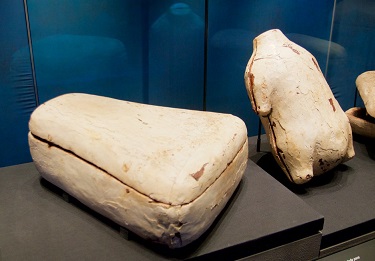 The ceramic sacophagi of two 'meat mummies' from Tutankhamun's tomb: the first contained a beef rib-joint, the second (obviously) an oven-ready duckling. 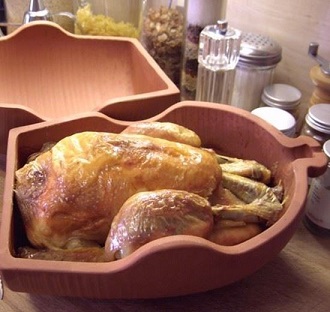 |
|   | | PaulRyckier
Censura

Posts : 4902
Join date : 2012-01-01
Location : Belgium
 |  Subject: Re: Dish of the Day - II Subject: Re: Dish of the Day - II  Wed 27 Nov 2019, 22:02 Wed 27 Nov 2019, 22:02 | |
| MM, the last picture has some "allures" of your Bed&Breakfast...I guess? More serious, MM, in the time I read about the mysterious deaths after the opening of the grave. But recently I read that it was probably caused by fungi and all. But now I read that it can be still a mystery. https://www.express.co.uk/news/weird/1060487/egyptian-curse-six-archaeologists-die-mysteriously-opening-sarcophagus-spt"Most of the deaths can be explained medically, however, of the 12 people present during the opening of the sarcophagus, six died mysteriously within a few months.”Today, archaeologists wear protective masks when entering such resting places. They are aware that bacteria active in the decomposed organic material can enter open wounds and spread infection. However, not all deaths can be accredited to this, in addition to the bizarre experiences some researchers still have following the openings.Some have detailed how they experienced very vivid dreams, claiming to be “haunted” by the mummies they apparently disturbed."But then you read a more serious source?https://www.livescience.com/44297-king-tut-curse.html" investigator James Randi notes that "the average duration of life for ... those who should have suffered the ancient curse was more than twenty-three years after the 'curse' was supposed to become effective. Carnarvon's daughter died in 1980, a full fifty-seven years later. Howard Carter, who not only discovered the tomb and physically opened it, but also removed the mummy of Tutankhamun from the sarcophagus, lived until 1939, sixteen years after that event."Not only did Carter live to a fairly ripe age of 64 before succumbing to cancer, but Sgt. Richard Adamson, a member of Carter's team who guarded the burial chamber round the clock for seven years and was the European closest to Tutankhamun's remains, lived for another 60 years until his death in 1982. And he is not alone; Randi notes, "This group died at an average age of seventy-three plus years, beating the actuarial tables for persons of that period and social class by about a year. The Curse of the Pharaoh is a beneficial curse, it seems."Kind regards, Paul. |
|   | | Meles meles
Censura

Posts : 5079
Join date : 2011-12-30
Location : Pyrénées-Orientales, France
 |  Subject: Re: Dish of the Day - II Subject: Re: Dish of the Day - II  Wed 27 Nov 2019, 22:25 Wed 27 Nov 2019, 22:25 | |
| Indeed, and some years ago Dr. Mark Nelson of Monash University in Australia published a study in the British Medical Journal comparing the life expectancies of those present at the breaking of the seals with other Westerners known to have been in Egypt at the time, and found no significant difference at all. Certainly Lord Carnavon died just six weeks after the opening of the tomb, but that was well attested as being entirely due to a mosquito bite on his cheek that became infected when he shaved over it (and antibiotics not being available for another couple of decades). |
|   | | Meles meles
Censura

Posts : 5079
Join date : 2011-12-30
Location : Pyrénées-Orientales, France
 |  Subject: Re: Dish of the Day - II Subject: Re: Dish of the Day - II  Thu 28 Nov 2019, 18:35 Thu 28 Nov 2019, 18:35 | |
| Today - it being the last Thursday of November - is the traditional date for the annual 'Martinmass Swan Dinner' hosted by the Vintner's Guild of the City of London (although Martinmass itself, the feast day of Saint Martin of Tours, is actually on November 11). On this day the guildsmen and their guests traditionally sit down to a grand dinner of roast swan - although nowadays it is more likely to be goose, which is also associated with Saint Martin: in humility and self-doubt Martin tried to hide himself amongst a flock of geese to avoid his parishoners when they wanted to appoint him their bishop. Martinmass is also the traditional date to slaughter the last of the livestock - geese included - that were now in peak condition before winter, having been fattened up in the post-harvest fields of stubble and on the last Autumnal fruits and nuts. But regardless of whatever is actually served, tonight's banquet at the Vintner's Hall is still called the 'Swan Dinner'. Swans are deemed 'royal birds' but there is a lot of confusion over what this means and they were never exclusively reserved for the royal diet. Depending on one's rank and the relevant sumptuary laws, if one owned a lake or watercourse one could eat one's own swans. All swans that were at liberty on open waters belonged to the Crown by prerogative right, but as long as the birds had their wings 'pinioned' and their bills marked, ownership could be granted to a landowner, bearing in mind that swans are effectively wild birds and so are free to travel onto other stretches of a river. Today the queen only claims her right to those birds on certain parts of the Thames that have not been marked by others. In addition to the monarch, there are not many other Thames swan owners, indeed currently there are only two - the London livery companies of the the Vintners and of the Dyers - who maintain their ancient rights to possess swans on the river. For centuries swans' bills were cut, nicked and scribed, with identifying marks that indicated the identity of the 'swannery' to which they belonged. All over the country abbots, bishops and wealthy landowners raised young swans for their tables and all marked their bird's bills with unique distinguishing marks. These swan marks were granted by the Crown to the various owners in a similar process to that of being issued a Crown licence to have permission to develop a deer park on your estate. Between 1450 and 1600 there were about 630 swan marks recorded for different owners of swans on London waters alone. This is the origin of the annual swan-upping conducted on the river Thames, when swans are rounded up and any newly-hatched birds are marked. Swan-upping is still conducted annually and with great ceremony during the third week of July, although these days it is more a census of the swan population and their overall health, and the birds are now marked with just a standard leg ring. 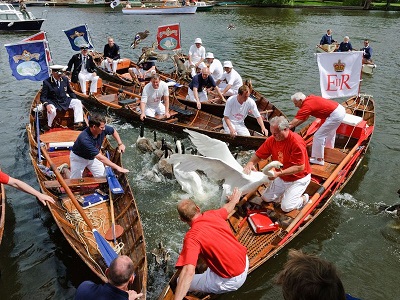 Swan-upping on the Thames. The queen holds the title of 'Seigneur of the Swans', hence the 'E II R' standard carried by the skiff of the officiating 'Queen's Swan Marker' - although in that photo he's sat in another boat - I think he's the chap furthest left in peaked cap and blue blazer. I'm guessing, but those in white with the blue standard probably represent the Vintners, while those in red and with the red standard I guess are from the Dyers. But essentially it is a collaboration rather than a competition, and in the inevitable scrum - swans are big powerful birds well able to resist being caught - people often end up in the 'wrong' boat, or even in the river. It is nowadays illegal to hunt and kill swans (except with a specific licence) although this is not because they are the exclusive preserve of Her Majesty, but rather it's a result of their being a protected species under the 1981 Wildlife and Countryside Act. This gives swans legal protection, but only in the same way that it is illegal to kill bustards, herons, storks, cranes, egrets, curlews, lapwings, dotterels, plovers, or any other such birds that were once, depending rank and sumptuary laws, legally allowed onto the dinner table. Swans and cygnets were sometimes raised for the table in the way of semi-domesticated poultry and even Mrs Beeton, writing in 1861, makes a passing reference to them sometimes being available in the poultry markets of London ... but then she also rather optimistically reckoned that you could still get British-caught sturgeon - the whole fresh fish that is, not just caviar - from Billingsgate fish market. 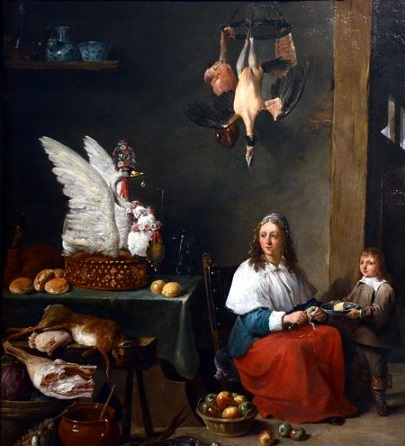 David Teniers the Younger, "Kitchen Interior" (1644) with a beautifully prepared swan ... and a rather bored, or just exhausted, swan-stuffer. A whole roast swan was obviously a big showy dish, especially as it was often prepared 'en-hackled', that is with the head, neck, skin and feathers carefully removed before cooking and then put back over the finished roast so that it resembled the living bird (as well as potentially giving everyone food poisoning). Swans however, at least when compared to ducks and geese, tend to have very little subcutaneous fat, and so the cooked meat of a mature swan is rather dry, tough and stringy. The flesh of younger birds is apparently more palatable, but these smaller cygnets have grey plummage and so are nowhere near as showy for a centerpiece dish (and anyway by Martinmass they will all have matured and toughened up). Accordingly it was more often the practice to cook swan meat in the form of a well-larded and sauced pie, suitably decorated with a second whole bird (or even a just a fake, wood-and-wire one) on top, onto which the skin and feathers could be decoratively draped.  This is a mock-up of such a grand swan pie prepared for an exhibit at the Museum of London to represent a typical medieval or Tudor guild dinner. It's certainly a bit more upmarket than the pies currently sold by Greggs. And here's a recipe for a swan pye from John Thacker's, 'The Art of Cookery' (1758) 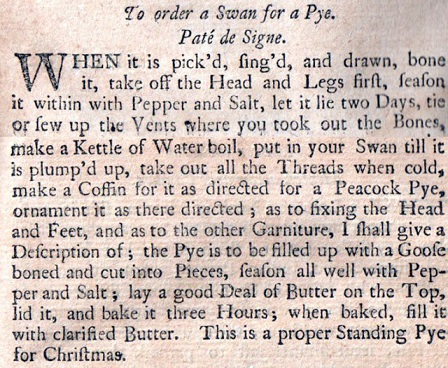 But even if you don't fancy swan or goose, tonight's banquet is hosted by the Vintner's company, and so you can rest assured that the wines will be very, very good. |
|   | | Meles meles
Censura

Posts : 5079
Join date : 2011-12-30
Location : Pyrénées-Orientales, France
 |  Subject: Re: Dish of the Day - II Subject: Re: Dish of the Day - II  Tue 03 Dec 2019, 08:54 Tue 03 Dec 2019, 08:54 | |
| 2 December 1804 – Napoleon Bonaparte crowned himself Emperor of the French, with the Pope, the Archbishop of Paris, and indeed everyone else just relegated to being passive observers. This was very much a one-man show.  'The Coronation of Napoleon' by Jacques-Louis David (1804). And so for today it's going to be those little puff-pastry-and-custard-cakes, usually known in France as milles-feuilles, ('thousand-leaves'), or in Britain as the custard or vanilla slice. Traditionally a mille-feuille is made up of three layers of puff pastry (pâte feuilletée) - which is itself comprised of many, often several dozens, of wafer-thin layers - alternating with two layers of pastry cream (crème pâtissière). The top pastry layer is often dusted with confectioner's sugar and sometimes cocoa, pastry crumbs, or pulverized seeds (such as roasted almonds). Alternatively, the top might be glazed with icing or fondant in alternating white (icing) and brown (chocolate) stripes and then combed to get a marbled effect:  ... stay with me and the relevance to Napoleon Bonaparte will eventually become apparent, honest. References to the ancestors of 'puff pastry' or 'pâte feuilletée' - that is a pastry made by building up thin dough layers, each one oiled or buttered to prevent them from sticking together - go back to antiquity. Even grumpy old Cato the Elder gives a recipe for 'placenta' - a multi-layered cheesecake - although his recipe only has five or so layers of rather biscuity, oil-based pastry (tractum) and so it's a long way from a deliciously-light, mille-feuille, 'thousand leaf', pastry. The classic Roman technique was however steadily improved upon, probably with Greek and perhaps Egyptian and Persian influences, to eventually evolve into in the light, layered, pastry sweetmeats, that were a regular feature throughout the Muslim and Byzantine world - for example in such delicacies such as baklava, spanakopita, or prasópita. The technique inevitably found its way to Muslim Spain, Renaissance Italy and thence to France. The method of layering oiled pastry sheets is first mentioned in one of the very earliest printed European cookbooks, the 'Libre del Coch' - or 'the cook's book', which, written in Catalan, was first published in 1520 in Barcelona. The author was given only as 'Maestre Robert', who identified himself as having been the cook to 'Ferrando, King of Naples'. The book was extremely successful: in the 16th century it was republished four more times in Catalan, and ten times in Spanish. The first Spanish edition, in 1525, entitled 'Libro de Cozina', called the author Ruperto de Nola, and he has been referred to by that name ever since. However the author's identity and nationality are still matters of speculation. He may well have been Catalan, since he wrote in that language, but if 'de Nola' was truly his surname then he may have been an Italian from the city of Nola in the province of Naples. The king 'Ferrando' that he claimed to have served was probably Ferrante I, King of Naples from 1458-1494, which is completely plausible as the Kings of Aragon had ancient claim over the Kingdom of Naples. In relation to the history of puff pastry, the Libro del Coch therefore forms an interesting bridge between Islamic, Andalusian, Aragonese and Neopolitan culinary influences. The first French mention of a true puff pastry recipe (resulting from the repeated folding and refolding of the buttered pastry layers) appears in François Pierre de La Varenne's cookbook, 'Le pastissier François' (1653), in which La Varenne gives general instructions for pastry making, as well as then giving recipes for two layered tortes/cakes: Tourte of Franchipanne (p. 200) and Tourte of Massepin (p. 201) - ie both are based on using a creamed marzipan/almond paste. But the first mention in French of a "mille-feuille", at least by that specific name, appears somewhat later in 1749, in a cookbook by 'Menon' (Menon is the pseudonym of a successful 18th-century French cookbook author whose true identity is still unknown). From Menon's 'La science du maître d'hôtel cuisinier, avec des observations sur la connaissance & propriétés des alimens' (1749), p.367 (in translation): "To make a mille-feuille cake, you take puff pastry, make out of it five cakes of equal size, & of the thickness of two coins, in the last one you shall make a hole in the middle in the shape of a Knight's cross, regarding the size you will base yourself on the dish that you will use for service, bake them in the oven. When they are baked & cooled, stack them one on the other, the one with the hole on top, & jams between every cake, [sentence unclear, maybe referring to covering all sides with jam] & ice them everywhere with white icing so that they appear to be a single piece; you can embellish it with some red currant jelly, candied lemon skins & pistachio, you serve them on a plate." In its modern form the millefeuille was certainly influenced by improvements made by the famous Marie-Antoine Carême ('Le Roi des Chefs et le Chef des Rois - the King of Chefs, and the Chef of Kings'). Careme was the principal chef for the prominent French politician and diplomat, Charles-Maurice de Talleyrand-Périgord, and so in his time he certainly prepared dinners for Napoleon. Napoleon was famously indifferent to food but he understood the importance of social relations in the world of diplomacy. In 1804 Napoleon gave money to Talleyrand to purchase Château de Valençay, a large estate outside Paris, with the château being intended to act as a kind of diplomatic gathering place, and when Talleyrand moved there, he took Carême with him. With the fall of of Napoleon in 1815, Carême went to London for a time and served as chef de cuisine to the Prince Regent, later George IV but they didn't enjoy an equitable relationship. Returning to the continent, Careme accepted the invitation of Tsar Alexander I to come to St. Petersburg, but stayed so briefly that he prepared not even a single meal for the Tsar. Upon returning to Paris again, he became chef to the international banker, James Mayer Rothschild. Here's one of Careme's recipes for a 'gateaux de milles-feuilles', taken from an 1865 reprint of the original 1816 edition of his book, 'Le Patissier National': Faites 1kg500 de farine en feuilletage de gâteau de roi , donnez 6 tours . Divisez le feuilletage en 16 parties , moulez et abaissez en rond de 18 centimètres , laissez reposer 2 heures . Mouillez le dessus de abaisses avec du blanc d’œuf et semez du sucre en poudre dessus . Piquez , pour éviter que les abaisses ne bouffent au four et faite cuire de couleur blonde ( four à 180 degrés ) . Lorsque toutes les abaisses sont cuites , laissez refroidir . Étalez de la marmelade d'abricots sur 8 abaisse et de la gelée de groseille sur les 8 autres . Placez les abaisses l'une sur l'autre en intercalant groseilles et abricots .
Lorsqu'elles sont placées , parez et masquez le tour avec de la marmelade de pomme très réduite , pour que la gâteau soit bien lisse.
Now, such light, layered cakes were generally described as being in the neapolitan-style (napolitain, in French) and small pastries like that were often called neapolitans/napolitains. Sometime around 1805 such patisseries started to be called napoleons, almost certainly as a topical corruption of napolitain (the word play works slightly better in French than English). I believe this was a deliberate attempt to capitolise on Napoleon's name for commercial purposes, although the association certainly did not damage the reputation and legacy of Napoleon himself. Furthermore I suspect that the idea may well have come from two specific people: Dunand, the personal chef to Napoleon, and Grimod de la Reynière, the epicure, foody journalist, and restaurant critic. Dunand, or Dunant (and his first name isn't known either) had been the chef to the Prince of Condé (that is Louis Joseph de Bourbon) for some years, until the Prince fled to Britain during the revolution. Abandoned by his patron, Dunand however struck lucky when he managed to get himself appointed as Napoleon's personal chef. In that rôle he accompanied Napoleon on the invasion of Russia and stuck with him for the rest of the Napoleonic Wars. Dunand however was certainly not beyond a bit of self-publiciy and manipulating facts to agrandize he own rôle in Napoleon's rise, and subsequent fall. (see Dish-of-the-Day, page 7 for 14 June 1800 and the story behing the origin of chicken Marengo). Dunand was professionally associated with Careme but he was also very friendly with the epicure and influential food journalist, Grimod de la Reynière, who we have also encountered here before (see Dish-of-the-Day, page 7 for 14 July 1790 and for 28 July 1794). In his annual restaurant review 'Almanach des gourmands' (it was somehat like the modern Michelin guide) for the year 1810, he specifically mentions mille-feuille as being sold in the best Parisian patisseries. He calls them 'mille-feuille', not napoleons, but he clearly indicates that these are no longer entire mille-feuille cakes, but are now being sold as small, individual, almost bite-sized, pastries. Either way for a period it seems the name, napolitains, for individual miile-feuille pastries, became corrupted to napoleons. In France the older name, mille-feuille, re-asserted itself after the fall of Napoleon and the restoration of the Bourbon monarchy, but it is still commonly used in north America, in Russia, parts of Scandinavia and indeed even still sometimes in France where a napoleon always has an almond cream filling, whilst a mille-feuille might well be filled with whipped cream, pastry cream, or even jam. Compare the following three recipes, firstly from Larousse Gastronomique, (New York, 1961) Napolitains
Ingredients. For a large napolitain: 2 1/4 cups (365 grams) blanched sweet almonds; 1 tablepsoon (12 1/2 grams) blanched bitter almonds; 1 14 cups (175 grams) fine sugar; 1/2 pound (250 grams) butter; 4 cups (500 grams) sieved cake flour; 1 3/4 cups (30 grams) sugar flavoured with lemon (or any other flavouring); a pinch of salt.
Method. Pound the almonds in a mortar with a little white of egg to bind them. When the almonds are pounded to a fine paste, add the fine sugar, the flavoured sugar, the butter and flour. Pounding constantly, add as many whole eggs as are required to make a very smooth and rather stiff paste. Take this paste out of the mortar and leave to stand for a while in a cool place. Roll out the paste. Cut it into square, round or hexagonal pieces. With a pastry cutter 2 inches in diameter, cut out the middle of each piece, except for two which will serve for the top and bottom layer of cake. Bake these layers of pastry in a hot oven. When the layers are quite cold spread each one with a different fruit puree or jelly. Put the layers one on top of the other, using an uncut layer to form the base, with alternate layers of jam or jelly. Cover with the other uncut layer. When the cake is built up, coat with golden apricot jam and pipe with royal icing.
Secondly from 'The Dinner Year-Book, by Marion Harland (New York, 1878); "Neapolitainoes or Napoleons
Make enough puff-paste for a pie; roll out into a sheet half an inch thick, and cut into strips three inches long and half as wide. Bake in a quick oven. When cold, spread half fo them with sweet jam or jelly, and stick the others over them in pairs--the jelly being, of course, in the middle. Ice with a frosting made of the whites of two eggs, whipped stiff with a half a pound of sugar. Make these on Saturday. Pass with them strong, hot coffee, with a great spoonful of whipped cream on the surface of each cupful."And lastly this from Urbain Dubois 'Grand livre de pâtisserie et des confiseur " (Paris 1867); Millefeuille à la Françasie
Cuisez 12 abaisse en feuilletage à 8 tours , en opérant comme il est dit dans l'article qui précède ; faites-les refroidir en trois piles ,sans mettre de poids dessus .
Masquez ensuite la moitié de ces abaisse , d'un coté seulement , avec une couche de gelée de framboise , et l'autre moitié avec une bonne frangipane . Montez alors le gâteau , en posant bien régulièrement les abaisses l'une sur l'autre , en alternant la framboise et la frangipane . Parez droit les contours, masquez-les avec de la marmelade d'abricots ferme ; masquez également le dessus . Laissez sécher la marmelade , 2 heure ; masquez-la ensuite avec une autre couche légère , au rhum .
Décorer le gâteau tout autour , avec des détails en feuilletage à blanc , avec de l'angélique et avec des amandes émondées ; sur le haut du gâteau , formez une rosace avec de la gelée blanche et rose coupée à l'emporte pièce . Ce gâteau doit être mangé à bref délai quand il est fini .Coincidently on the 46th anniversary of Napoleon's coronation, on 2 December 1851, Napoleon's nephew, the French President Louis-Napoléon Bonaparte, having failed to get himself constitutionally re-elected, launched a coup d'etat to remain in office. He then, exactly a year later on 2 December 1852, declared himself Emperor of the French, as Napoleon III - using exactly the same form of address as Napoleon Bonaparte, Napoleon I, did in 1804. So in conclusion here is a picture of another dish taken from Dubois' book, which this time uses milles-feuilles, augmented by biscuit layers, to construct a towering rather preposterous cake, balanced on an ornate stand. The cake itself actually comprises only about a third of the height of the entire presentation ..... but that is typical of the flamboyant Second French Empire period under Napoleon III, n'est ce pas? 
Last edited by Meles meles on Tue 31 Mar 2020, 09:37; edited 2 times in total |
|   | | Meles meles
Censura

Posts : 5079
Join date : 2011-12-30
Location : Pyrénées-Orientales, France
 |  Subject: Re: Dish of the Day - II Subject: Re: Dish of the Day - II  Wed 04 Dec 2019, 19:37 Wed 04 Dec 2019, 19:37 | |
| Only for completeness, but while looking for something else I've just come across a recipe for a completely different type of cake/bun also called a "Napoleon", in Frederick Vine's 'Saleable shop goods for counter-tray and window', (published in London, 1907). This was a practical manual for professional bakers and confectioners - unfortunately it's been scanned with OCR and so not all the quantities are clear, but it's obviously not a fluffy, light pastry-and-cream sandwich, but more like a sweet, brioche-style, currant bun: No. 40.- Napoleons. 1 lb. butter. 1 lb. sugar. 2 lbs. flour. 1 1/ 2 lbs. currants. ? lb. peel. ? oz. volatile. 10 eggs. Milk. Mode - Cream up the butter and sugar, adding the eggs in the usual way. Break the volatile down in a mortar with a little milk, and beat it well into the mixture; then mix in the flour and fruit, using sufficient milk to form a nice workable cake batter. Grease some Napoleon tins (see illustration. Fig. 23) and fill them with a palette knife, dredge a little sugar over and bake in a warm oven. This will make sixty cakes. Of course, should any mixture prove too large for your trade, it can be proportionately reduced. Sell at 1d. each. And then there's also this one from 'Miss Drake's Home Cookery' by Lucy Drake, 10th edition, (publ. Melbourne, Australia, 1940). 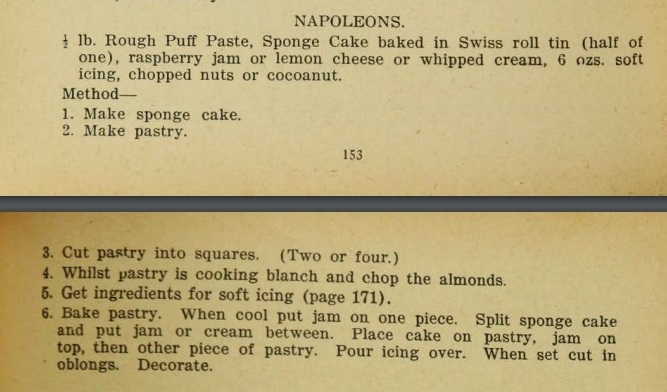 |
|   | | PaulRyckier
Censura

Posts : 4902
Join date : 2012-01-01
Location : Belgium
 |  Subject: Re: Dish of the Day - II Subject: Re: Dish of the Day - II  Sat 07 Dec 2019, 22:31 Sat 07 Dec 2019, 22:31 | |
| MM, thank you very much for your two messages about the mille feuilles and the first one about the swan dinner, especially about the history behind it all. I spoke already with LiR about your mille feuilles pastry. We called it a "boekje" (small book) and although I am remembering mille feuilles with more layers of feuilleté in between filled with vanilla pudding I found now on internet only as you said the "traditional" ones:  And it seems that they call those with one layer of pudding in between the feuilleté a "Tom Pouce"? I think I will have to ask an "old" pâtissier about it all. But the difficulty is that I don't enter anymore in, as we call it, "patisseries", for fear of my line, as I am nearly addicted to pastry, especially with a lot of "chantilly". And the doctor said, as I am taking stuff against the post operative rejection of my transplant kidney, I have to be cautious with pastry and chocolates (another addiction) for sugar level in the blood. The general practician said that that was a "routine" caution from those specialists  ... Kind regards, Paul. |
|   | | Meles meles
Censura

Posts : 5079
Join date : 2011-12-30
Location : Pyrénées-Orientales, France
 |  Subject: Re: Dish of the Day - II Subject: Re: Dish of the Day - II  Sat 07 Dec 2019, 22:56 Sat 07 Dec 2019, 22:56 | |
| I'd never come across a millefeuille 'Tompouce' (that's Tom Thumb in English) before. Looking on line it seems to be a particular Belgian and Dutch speciality. I'd assumed the name was simply because they are smaller than a regular French millefeuille, but wiki says they were introduced by an Amsterdam pastry baker and named after Admiraal Tom Pouce, the stage name of the Frisian dwarf Jan Hannema (1839-1878).  Wiki also says that traditionally the top layer has been orange on Koningsdag (King's Day) in the Netherlands ie April 27. Thanks for drawing tompouce/tompoes and boekske to my attention. |
|   | | Meles meles
Censura

Posts : 5079
Join date : 2011-12-30
Location : Pyrénées-Orientales, France
 |  Subject: Re: Dish of the Day - II Subject: Re: Dish of the Day - II  Sat 07 Dec 2019, 23:32 Sat 07 Dec 2019, 23:32 | |
| 8 December 1660 – A woman appeared on the stage of an English public theatre for the first time, when a professional actress played Desdemona in a performance of Othello at Thomas Killigrew’s Vere Street Theatre in Lincoln's Inn Fields.  Othello with the murdered body of Desdemona - from the first illustrated edition of 'The works of Mr. William Shakespear' (1709) edited by Nicholas Rowe and illustrated by the French-born artist François Boitard. Desdemona’s exposed body rather indicates the salacious way that actresses were generally seen in the late 17th and early 18th centuries. In Shakespeare’s London the cast in the playhouses was always entirely male, with adolescent boys and young men playing the female roles. Women often took key roles in court masques and at other strictly private events - such as the group of touring French actresses that performed at several courties' residences in 1629, although apparently to rather unappreciative audiences. At the other end of the social scale women had frequently appeared as entertainers in alehouses, taverns, bawdy houses, and at temporary fairs and markets. Indeed they might well have been part of a long-established, profitable and successful, troupe of itinerant players, but they could never be part of any regular theatrical company. The theatres were always seen as morally dubious places and potential nests of sedition and vice, and so they required government licence to operate and were subject to very strict controls: to openly feature women on stage would have led to immediate closure and heavy penalties. Then in 1642 the Puritan Long Parliament banned all stage plays: the theatres were closed down and public playing completely disappeared, even from illicit alehouse venues. But when Charles II and his supporters returned to England in 1660 to restore the monarchy, they brought with them an enthusiasm for the theatre that they had cultivated during their time in exile at the French court of King Louis XIV. In particular, they had developed an appreciation for the French professional actresses and were keen to instil this continental tradition in the English playhouses. Charles's enthusiasm was probably not entirely esthetic: French actresses, when playing women, deliberately wore costumes with plunging neck-lines that exposed the bust, and when playing the roles of young men and boys, as was the French custom, it meant they often wore tight-fitting breeches or hose that revealed the shape of their calves and thighs, and even sometimes, their buttocks. When that first actress stepped out onto the stage in December 1660 it was still strictly illegal, but in the changed circumstances of the Restoration it seems everyone, or at least nearly everyone, was prepared to turn a blind eye for a bit of daring novelty and risqué titillation. (Charles II formally lifted the ban by decree in 1662, although only for the two government-approved London theatre companies; those run by William Davenant and by Thomas Killigrew). The details of the performance in question are accurately known: the date; the place; and that it was a performance of Othello with a woman playing Desdemona, but her name is unrecorded in theatrical accounts. She has usually been identified as Magaret Hughes although the concensus now seems to be that the performance starred Anne Marshall (later Mrs Quin, or Guin), but either way both women played the role in various performances over the following years. This first performance had an air of backstreet mystery and illicit novelty. In a prologue written especially for the occasion, the actor and poet Thomas Jordan warned the audience that a real actress would appear that night as Desdemona, and he quickly underlined the sexual potency of the historic moment. Just as Shakespeare’s Othello demands 'ocular proof' about his wife’s character and behaviour (3.3.360), Jordan's prologue voyeristically starts by saying how he has just seen her backstage getting dressed, and she most definitely is not a man: I come unknown to any of the rest,to tell you news, I saw the Lady dress’t,the woman playes to day, mistake me not,No man in Gown, or Page in Petty-Coat,A woman to my knowledge, yet I cann’t(If I should dye) make affidavit on’t.But then after a bit the prologue changes to downplay the sexual aspect and he chides his audience for any salacious thoughts and asks them to judge her, without prejudice, for her skill as an actress: ...Do you not twitter Gentlemen? I knowYou will be censuring, do’t fairly though;‘Tis possible a vertuous woman mayAbhor all sorts of looseness, and yet play....[She is ] as far from being what you call a Whore, As Desdemona injur’d by the Moor.The prologue sums up by underlining the disadvantages of a man playing a female lead: ...But to the point; in this reforming ageWe have intents to civilize the Stage.Our women are defective, and so siz’dYou’d think they were some of the Guard disguiz’dFor (to speak truth) men act, that are betweenForty and fifty, Wenches of fifteen;With bone so large, and nerve so incomplyant,When you call Desdemona, enter Giant.Pivotal as it was, Anne Marshall’s (or Margaret Hughes') star turn as Desdemona did not change English theatre overnight. Initially women on stage were seen mostly as a novelty until it became common practice, and male actors continued to perform female roles well into the Restoration. These 'boy players' were an established part of the theatre and had often developed a huge following among both men and women. For example Edward Kynaston (born 1640) had numerous wealthy female fans who used to take him (often dressed in full female Shakespearean costume) for public carriage rides just so they could be seen together; while Samuel Pepys, having watched him perform as 'the Duke's sister' in John Fletcher's play 'The Loyall Subject', went for a drink with him afterwards and later confided in his diary (18 August 1660) that he though he made, "the loveliest lady that ever I saw in my life, only her voice not very good". But the increasing frequency of females being cast gradually pushed the boy players out, although In no way did this mean gender equality: female players were paid considerably less than their male counterparts. In one way, being an actress was a valid way to climb the social ladder. A lady of the stage need not be of a high class, largely because upper-class women would find acting indecent, but she did need to be educated enough to read, write, and act like a dignified woman. The role required an understanding of manners even without them being practiced in daily life. Acting was considered a low-class profession, but despite its lack of status, it paid more than domestic service. More than that, it exposed actresses to wealthy courtiers. This was extremely valuable for them: becoming the mistress of a rich man was not at all a bad life for a woman of medium to low social class. And not only did women assume roles as actors, but the Restoration also saw the first female dramatists. So anyway, what sweetmeats and munchies shall we take to the theatre tonight? There is a classic Danish cake, Othellolagkage – 'Othello Layered Cake', consisting of custard cream, a macaroon bottom and chocolate icing, decorated with a marzipan border and butter icing swirls. I don't know why it is so named (Neilsen?) - afterall, unlike Hamlet, Othello is not set in Denmark - probably it's simply because it combines dark chocolate icing with white butter icing.  mydanishkitchen.com - othellolagkage mydanishkitchen.com - othellolagkageBut i think in honour of Anne Marshall's performance we need to specifically include Desdemona as well. So how about the little iced cakes called Desdemonas and Othellos. From 'Miss Drake's Home Cookery' by Lucy Drake, 10th edition (publ. Melbourne, Australia, 1940), there's this;  Desdemonas and Othellos seem to be a bit of an Australian speciality with recipes appearing in several different Australian newspapers and cookbooks going back to the 1880s. The only non-Australian recipe I can find appears in Frederick Vine's 'Saleable shop goods for counter-tray and window' (London, 1907), which was a practical manual for professional bakers and confectioners. Again they are small sponge cakes one lot topped with dark chocolate the other with white fondant icing. If the recipe did originate in Australia I wonder how it came to London, to appear in just one British cookbook but no others (at least not any that I can find).  Modern Desdemonas and Othellos baked to Miss Drake's 1940 recipe (though I'm not sure why one Desdemona is sitting on an Othello). |
|   | | PaulRyckier
Censura

Posts : 4902
Join date : 2012-01-01
Location : Belgium
 |  Subject: Re: Dish of the Day - II Subject: Re: Dish of the Day - II  Mon 09 Dec 2019, 20:13 Mon 09 Dec 2019, 20:13 | |
| - Meles meles wrote:
- I'd never come across a millefeuille 'Tompouce' (that's Tom Thumb in English) before. Looking on line it seems to be a particular Belgian and Dutch speciality. I'd assumed the name was simply because they are smaller than a regular French millefeuille, but wiki says they were introduced by an Amsterdam pastry baker and named after Admiraal Tom Pouce, the stage name of the Frisian dwarf Jan Hannema (1839-1878).
Wiki also says that traditionally the top layer has been orange on Koningsdag (King's Day) in the Netherlands ie April 27. Thanks for drawing tompouce/tompoes and boekske to my attention. MM, thank you for your explanation about Admiraal Tom Pouce. What one learns each day here on this site... And yes (I hope Dirk is not "such" a Dutchman), since the Dutch welcomed their "Oranje Prince" later made king by the Congres of Vienna, they become each year a bit crazy on that day...although the King has to do it with the title only as it is a Prince of Orange without land (Louis XIV took it from him) And as I understand it that was the end of the Dutch Republic. https://en.m.wikipedia.org/wiki/William_I_of_the_NetherlandsFrom the wiki: He was formally confirmed as hereditary ruler of what was known as the United Kingdom of the Netherlands at the Congress of Vienna.https://en.wikipedia.org/wiki/Principality_of_Orange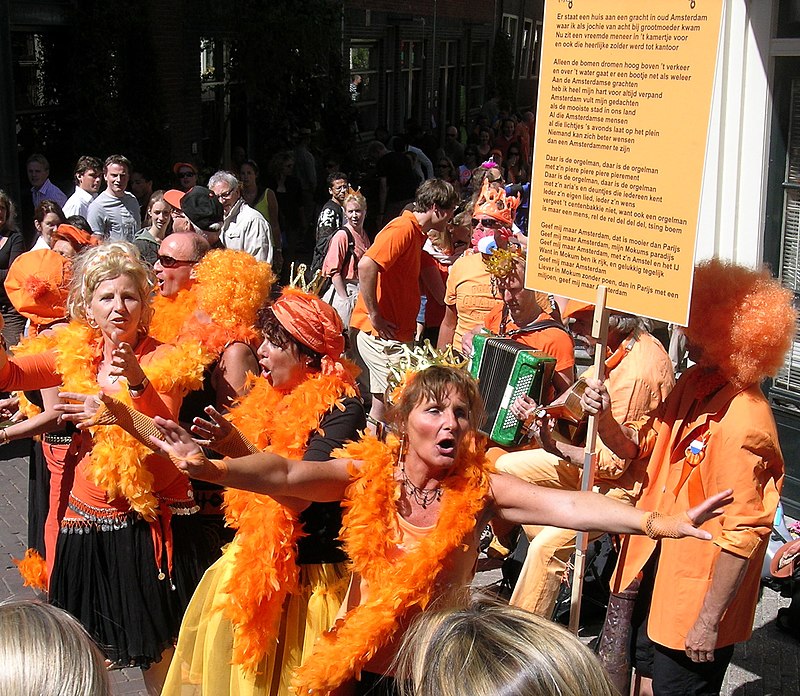 Kind regards, Paul. |
|   | | PaulRyckier
Censura

Posts : 4902
Join date : 2012-01-01
Location : Belgium
 |  Subject: Re: Dish of the Day - II Subject: Re: Dish of the Day - II  Mon 09 Dec 2019, 21:42 Mon 09 Dec 2019, 21:42 | |
| MM, thank you very much for again a interesting piece of history accompagnied as usual by some pastry recepts. - Meles meles wrote:
- Modern Desdemonas and Othellos baked to Miss Drake's 1940 recipe (though I'm not sure why one Desdemona is sitting on an Othello).
MM, I am nearly sure that you expected something  , as we say in West-Flemish: "allez gauw". Suddenly after some thinking, I came on the Dutch equivalent..."komaan zeg" and that way I could seek for a translation: French: "allons, soyons sérieux", English: "come on, say"... I think the "Ollanders" would perhaps also say: "foei" they translate by "shame on you"  But now I digress as usual, and it would be more on its place on the language board... They translate "foei" also by "fie" https://www.merriam-webster.com/thesaurus/fieas the etymology of foei and fie something to do with each other? Kind regards, Paul. |
|   | | Meles meles
Censura

Posts : 5079
Join date : 2011-12-30
Location : Pyrénées-Orientales, France
 |  Subject: Re: Dish of the Day - II Subject: Re: Dish of the Day - II  Tue 10 Dec 2019, 08:47 Tue 10 Dec 2019, 08:47 | |
| Besides which there were rival hereditary claims to Orange ... as I remember, Kaiser Wilhem II also counted 'Prince of Orange' amongst his many titles, but as you say there is no actual land associated with it. The city and territory of Orange/Oranje/Aurenjo is just north of Avignon in the south of France and has been firmly French since Louis XIV annexed it in 1713.
Maar, uit schaamte 'foei' omdat ik het begrijp. ...but, I understand 'foei' very well. My friend Rita from Geraardsbergen often uses it to her husband ("oh Jan, foei"); the children ("foei, doe dat niet, Joris"): or the dog ("Nee! Oh Nooka, foei, feoi, foei") - when they have either said something inappropriate or done something naughty. |
|   | | PaulRyckier
Censura

Posts : 4902
Join date : 2012-01-01
Location : Belgium
 |  Subject: Re: Dish of the Day - II Subject: Re: Dish of the Day - II  Tue 10 Dec 2019, 23:13 Tue 10 Dec 2019, 23:13 | |
| - Meles meles wrote:
- Besides which there were rival hereditary claims to Orange ... as I remember, Kaiser Wilhem II also counted 'Prince of Orange' amongst his many titles, but as you say there is no actual land associated with it. The city and territory of Orange/Oranje/Aurenjo is just north of Avignon in the south of France and has been firmly French since Louis XIV annexed it in 1713.
MM, indeed that of Kaiser Wilhelm is in the wiki I mentioned I think. Found it: " As an independent enclave within France, Orange became an attractive destination for Protestants and a Huguenot stronghold. William III of Orange, who ruled England as William III of England, was the last Prince of Orange to rule the principality. The principality was captured by the forces of Louis XIV under François Adhémar de Monteil Comte de Grignan, in 1672 during the Franco-Dutch War, and again in August 1682, but William did not concede his claim to rule. In 1702, William III died childless and the right to the principality became a matter of dispute between Frederick I of Prussia and John William Friso of Nassau-Dietz, who both claimed the title 'Prince of Orange'. In 1702 also, Louis XIV of France enfeoffed François Louis, Prince of Conti, a relative of the Châlon dynasty, with the Principality of Orange, so that there were three claimants to the title.Finally in 1713 in the Treaty of Utrecht, Frederick I of Prussia ceded the Principality to France (without surrendering the princely title) in which cession the Holy Roman Empire as suzerain concurred, though John William Friso of Nassau-Dietz, the other claimant to the principality, did not concur. Only in 1732, with the Treaty of Partage, did John William Friso's successor William IV, Prince of Orange, renounce all his claims to the territory, but again (like Frederick I) he did not renounce his claim to the title. In the same treaty an agreement was made between both claimants, stipulating that both houses be allowed to use the title."I was there, when I was in Avignon (by Thalis).Orange, has one of the best preserved Roman theatres of the world.The finest wall in my kingdom said Louis XIVhttps://www.theatre-antique.com/en/discovering-site/roman-theatre-orange
 The guide said that on a certain moment they were used as horse stalls for the army and when I visited it the modern glass stage roof wasn't yet there. In fact Avignon is a magnificent destination. And all around you have special cities and places as I just said Orange (31 km), Arles (Van Gogh) (46 km), Pont du Gard (roman aquaduct) (26 km), Châteauneuf-du-Pape (19km) (if you can spent that much money for a bottle). You can all reach it by train as we did, (each time 25 Euro in that time for a "retour") As I read this evening about your dire circumstances due to your telephone connections I hope that once the nightmare is over again you will find the time among all your "besognes" to visit these cities. But I guess you did it already before? MM, I think that I can speak in the name of our whole RH team, to wish you an end to your difficulties and a bright next year. Kind regards from your friend Paul. |
|   | | Nielsen
Triumviratus Rei Publicae Constituendae

Posts : 595
Join date : 2011-12-31
Location : Denmark
 |  Subject: Re: Dish of the Day - II Subject: Re: Dish of the Day - II  Wed 11 Dec 2019, 06:28 Wed 11 Dec 2019, 06:28 | |
| Above MM refers to the Othello layered cake - mydanishkitchen.com - and ask whether I know anything, alas, the Danish wiki is - as usual - far from useful, and just mentions that 'the Othellokagen is a Danish layered cake with whipped cream named after the Shakespeare play by that name. This was a Danish invention from about 1900. ...'
The recipe is mentioned above in MM's piece.
According to my taste buds, this ought to be eaten in small doses with strong black coffee.
Kind regards from me as well. |
|   | | Meles meles
Censura

Posts : 5079
Join date : 2011-12-30
Location : Pyrénées-Orientales, France
 |  Subject: Re: Dish of the Day - II Subject: Re: Dish of the Day - II  Sun 15 Dec 2019, 14:40 Sun 15 Dec 2019, 14:40 | |
| 15 December 1933 – Prohibition ends in the United States. The Twenty-first Amendment to the U.S. Constitution, having been ratified on 5th December, became effective on 15th December, thereby repealing the Eighteenth Amendment that prohibited the sale, manufacture and transportation of alcohol. So cheers! bottoms-up! prost! and generally, drinks all round. The U.S. Senate had proposed the Eighteenth Amendment (to prohibit alcohol) on 18 December 1917, and upon being approved by a 36th state (the necessary two-thirds majority) on 16 January 1919, the amendment was duly ratified as a part of the U.S. Constitution. By the terms of the amendment the whole country went dry one year later on 17 January 1920. 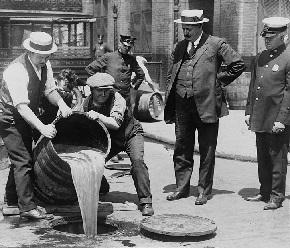  Illegal liquor is poured into a sewer in New York following a raid during the height of prohibition ... but not everyone, it seems, is happy about it. Prohibition was successful in reducing the amount of liquor consumed, cirrhosis death rates, admissions to state mental hospitals for alcoholic psychosis, arrests for public drunkenness, and rates of absenteeism. But it was not at all popular and it destroyed tens of thousands of previously legitimate businesses, as well as costing the state in lost tax revenue. Almost inevitably it stimulated the proliferation of underground, organized and widespread criminal activity as the production, importation, and distribution of alcoholic beverages — once the province of legitimate business — were taken over by criminal gangs, which fought each other for market control. Furthermore implementation of the law was continually being undermined: many, otherwise completely law-abiding citizens, were sympathetic to the so-called 'bootleggers' (smugglers). Inevitably even respectable citizens - especially those with ready cash to hand - were lured by the romance of illegal 'speakeasies' (illegal bars serving alcohol) to such a degree that by 1925 there were anywhere from 30,000 to 100,000 speakeasy bars, all illegal, operating clandestinely, yet widely-known, in New York City alone. As more and more citizens opposed the Eighteenth Amendment, a political movement grew for its repeal. However, repeal was complicated by grassroots politics. Although the U.S. Constitution provides two methods for ratifying constitutional amendments, only one method had been used until that time; and that was for ratification by the state legislatures of three-fourths of the states. However, the wisdom of the day was that the lawmakers of many states were either beholden to or simply fearful of the temperance lobby. For that reason, when Congress formally proposed the repeal of Prohibition on 20 February 1933 (with the requisite two-thirds having voted in favor in each house; 63 to 21 in the United States Senate and 289 to 121 in the United States House of Representatives), it chose the other ratification method established by Article V, that being via state conventions. To date the Twenty-first Amendment is the only constitutional amendment ratified by state conventions rather than by the state legislatures. The proposed amendment was adopted on 5 December 1933. The Twenty-first Amendment ending national prohibition became officially effective on 15 December 1933, just in time for Christmas, although inevitably people had started drinking openly before that date. Cooking with alcohol is of course a very important component of many cuisines. In many cases - such as coq au vin, boeuf bourgignon, beef with beer, chicken in cider, lapin au riesling, etc, - the alcohol is mostly boiled off during cooking. But there are plenty of recipes that use alcohol at the end when it is not eliminated before serving: a spoonful of Madeira perks up oxtail soup when added just before serving, and cranachan would not be the same without its dash of whiskey. But to suitably mark today I think we need, not just with a wee dash of alcohol, but a rather more substantial slosh of the hard stuff. Accordingly I propose a rum baba / baba au rhum, which, although it might these days be sometimes made with no alcohol at all, is, at least in its classic form, a small yeast cake completely drenched in rum ... and then very often filled with whipped cream as well, just for extra decadence.  A rum baba or baba au rhum. The original form of the baba was probably similar to babka, which is a cylindrical, braided yeast cake of Ashkenazi Jewish origin. (The name means "old woman" or "grandmother" in most Slavic languages; babka being a diminutive of baba). Today however, the word "baba" in France and almost everywhere else outside eastern Europe usually refers specifically to the rum baba. In this form the cake is usually like a smaller version of an Austrian Gugelhupf, which is a rich sweet cake baked in a circular mould, often called a bundt mould after yet another related cake, that gives it the distinctive doughnut shape. 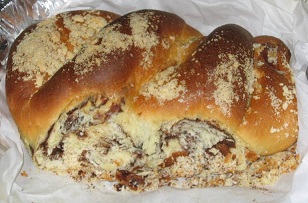 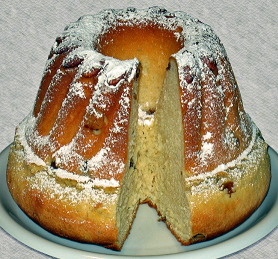 A Polish/Lithuanian Baba/Babka ..... and an Austrian Gugelhupf ...  ... and a Germanic Bundt cake. The original 'baba' seems arrived in France in the 18th century, with its widespread adoption being attributed to Stanislaus I, the king of Poland, then living in exile in French Lorraine. According to 'Le Larousse Gastronomique', Stanislaus, finding the local Gugelhupf (a cake common in Alsace-Lorraire, roughly similar to the Polish/Lithuanian baba/babka) too dry for his liking, he habitually dipped it in brandy or sweet wine. Another version is that when Stanislaus brought back a babka or similar sweet cake, from one of his voyages 'home' to Eastern Europe, it had dried up. So Nicolas Stohrer, one of his pâtissiers, solved the problem by adding Malaga wine and crême pâtissière.  King Stanislaus I - Louis XV's father-in-law and, from his well-upholstered jowls, clearly a man who liked his food. Stohrer followed Stanislaus's daughter Marie Leszczyńska to Versailles as her pâtissier in 1725 when she married King Louis XV. He founded his famous pâtisserie in Paris in 1730, and it was one of his descendants who in 1835 allegedly had the idea of using rum, rather the brandy. While he is believed to have done so on the fresh cakes (ie straight out of the mold), it is a common practice today to let the baba dry a little so that it soaks up the rum better. Rum Baba Ingredients 120 g plain flour 150 g caster sugar 10 g baking powder 50 g melted butter 3 eggs (separated) 3 tbsp warm milk dark rum Instructions Pre-heat oven to 180°C. Cream egg yolks and sugar. Add the warm milk, melted butter, sifted flour and baking powder. Mix well. Whisk egg whites till stiff, and gently fold into first batter. Pour into individual buttered and floured cake molds. Bake for about 15 minutes (until a toothpick comes out clean). Leave to cool on a wire rack for 10 minutes. Turn out the cakes, let dry a little bit, then drench with rum. For variety you can glaze the cakes with apricot preserves and/or add whipped cream. |
|   | | PaulRyckier
Censura

Posts : 4902
Join date : 2012-01-01
Location : Belgium
 |  Subject: Re: Dish of the Day - II Subject: Re: Dish of the Day - II  Sun 15 Dec 2019, 22:16 Sun 15 Dec 2019, 22:16 | |
| MM, thank you again for this new episode in your historical dishes and the history behind. To start with I have eaten baba au rhum and I like patisserie with liquors. But some domestic made baba au rhums can be pretty strong as if they have dipped or soaked in Stroh Rum 80 (80% alcohol)  OOPS quite large picture, but I found no smaller... To focus on your story of the link between Poland and France via Stanislas' daughter Marie Leszczyńska...I came first to her and via her to the exiled Polish king given Lorraine by the French king Louis XV, his son-in-law, by reading the novel about Marie's life by Geneviève Chauvel: le don d'aimer (the gift of loving)https://www.amazon.fr/don-daimer-Marie-Leczinska-France/dp/2857044992(has nobody a link to a free "shortener", which works?)  description in French: http://enviedhistoire.canalblog.com/archives/2006/10/27/3015428.htmlAnd Stanislas https://en.wikipedia.org/wiki/Stanis%C5%82aw_Leszczy%C5%84skibuilt in "his Lorraine", especially in the city of Nancy: http://enviedhistoire.canalblog.com/archives/2006/10/27/3015428.htmlAnd it was not only baba au rhum, which was introduced by the Poles in the French cuisine: https://www.wikiwand.com/en/French_cuisine" Shortly before the French Revolution, dishes like bouchées à la Reine gained prominence. Essentially royal cuisine produced by the royal household, this is a chicken-based recipe served on vol-au-vent created under the influence of Queen Marie Leszczyńska, the wife of Louis XV. This recipe is still popular today, as are other recipes from Queen Marie Leszczyńska like consommé à la Reine and filet d'aloyau braisé à la royale. Queen Marie is also credited with introducing lentilles to the French diet."Kind regards, Paul. |
|   | | Meles meles
Censura

Posts : 5079
Join date : 2011-12-30
Location : Pyrénées-Orientales, France
 |  Subject: Re: Dish of the Day - II Subject: Re: Dish of the Day - II  Wed 25 Dec 2019, 14:35 Wed 25 Dec 2019, 14:35 | |
| 25 December 1660 - This was the first Christmas after Charles II's restoration to the English throne and hence the first Christmas to be celebrated as a religious festival and legal public holiday since all Christmas festivities had been banned by the Puritan government in 1645. In January 1645 Parliament had enlisted the help of a group of ministers to create a 'Directory of Public Worship' establishing a new organisation of the church and new forms of worship that were to be adopted and followed in both England and Wales. According to the Directory, the population was to strictly observe Sundays as holy days and were not to recognise other festival days, including Christmas, since they had no biblical justification. Two years later Parliament reinstated the law by passing an Ordinance affirming the abolition of the feasts of Christmas, Easter and Whitsun. Obviously Christmas day itself had not been banned, but by law it was not to be especially celebrated and was to be treated like any other day: all shops, markets and workplaces were required to remain open; there were penalties for holding or attending a special Christmas church service, or even just putting seasonal decorations on the front door; and there was certainly to be no obvious drinking, feasting, gift-giving, dancing, games and any of the general lord-of-missrule stuff which might lead to drunkenness, promiscuity, gambling and other forms of excess, and so generally threaten the core tenets of Puritan belief. In London throughout the interregium the army was regulalry deployed onto the streets over the Christmas period, specifically to tear down mistletoe and holly boughs, to arrest anyone singing carols or performing nativity plays, and even to seize any food they suspected was being prepared for a Christmas celebration. Ineviably there were violent scuffles and even full-blown riots in many towns; most seriously in London, Bristol, Canterbury and Norwich. Charles II returned from exile in France in May 1660 and legally his reign was deemed to have started immediately upon the execution of his father in 1649. Accordingly all legislation passed by the Puritan Long Parliament during the interregium was declared invalid. So in December 1660 people could once again mark the Twelve Days of Christmas: old traditions were revived with renewed enthusiasm and Christmas was once again celebrated throughout the country as both a religious and secular festival. Robert May's 'The Accomplist Cook' (first published in 1660 immediately following the Restoration) is generally my first point of reference when searching for mid-seventeenth century recipes or menus, and again he hasn't let me down. Here's his suggested 'Bill of Fare', that is a menu idea, for a lavish Christmas Day feast - and note that he can now (1660) clearly say that it is for the celebration of Christmas:  All that food is just for Christmas Day, the 25th, but in 1660 doubtless the feasting went on for the full Twelve Days (indeed you can see the start of May's suggested menu for January 1st, which is similarly lavish, and indeed continues over onto the next page). But remember also that all these menus are intended to be served in the then usual, à la française style, in which all the dishes of a course (there are only two courses here) were served simultaneously and they were intended to completely smother the table with choice. You were not expected to sample every dish presented, and indeed to ask for something out of reach to be passed to you - and thus, albeit temporarily, break the intricate symmetry of the table - was generally thought the height of bad manners. This is a detail from the coronation feast of Charles II's successor, James II, in 1685 - but you can see how contemporary feasts were served with everything presented all at once and in a rigid display of an almost over-whelming choice of dishes: baked fish and fowls, alongside roasted meat joints, cream custards, pork pies, delicate salads, meaty beef stews, sweet fruit tarts, meatballs in sauce, and fried, crispy cheese fritters ... but all presented alongside each other and at the same time.  And let's not forget that in 1660 Christmas was only restored as a public holiday in England and Wales .... in Scotland Christmas did not again become a legally-sanctioned public holiday until 1957 ... nearly three centuries after it had originally been abolished. |
|   | | PaulRyckier
Censura

Posts : 4902
Join date : 2012-01-01
Location : Belgium
 |  Subject: Re: Dish of the Day - II Subject: Re: Dish of the Day - II  Wed 25 Dec 2019, 23:26 Wed 25 Dec 2019, 23:26 | |
| MM, thanks for another historic dish story. yes about that pragmatic Charles II, who knew what the English people needed. https://en.wikipedia.org/wiki/Charles_II_of_Englandreally the same manners as his grandfather Henry IV of France (Paris vaut bien une messe) https://en.wikipedia.org/wiki/Henry_IV_of_FranceMM, I learned today for the first time about Scotland that had to wait until 1957 for their Christmas day. Although you and others mentioned it already, I am each time still not used to the term: "the Twelve Days" But we have then, at least for the older people as I, the term known as: "de zes donkere weken" (the six dark weeks?). Three weeks before Christmas and three weeks after Christmas. At least we can already look again for the summer as the days are now lengthening  ... MM, first a warning: I am known for my "dur de comprenure"... " But remember also that all these menus are intended to be served in the then usual, à la française style, in which all the dishes of a course (there are only two courses here) were served simultaneously and they were intended to completely smother the table with choice. You were not expected to sample every dish presented, and indeed to ask for something out of reach to be passed to you - and thus, albeit temporarily, break the intricate symmetry of the table - was generally thought the height of bad manners."Two questions:Did that mean that one had to eat one dish and then that the servant took the empty dinner plate and replaced it by the following one?And were that all cold dishes? While one can imagine that the last dinner plate would contain a cold dish, if it was hot before?Kind regards from Paul. |
|   | | LadyinRetirement
Censura

Posts : 3301
Join date : 2013-09-16
Location : North-West Midlands, England
 |  Subject: Re: Dish of the Day - II Subject: Re: Dish of the Day - II  Thu 26 Dec 2019, 14:09 Thu 26 Dec 2019, 14:09 | |
| MM (and everyone) I think it's known that I'm a sap for a historical mystery novel (and for a sword and sorcery story) and I read a novel by a writer called Shirley McKay about "A Calendar of Crime". In the notes to her novel she mentions that post-Reformation in Scotland there was a part of the population that deemed some of the Christmas customs to be pagan and discouraged if not downright banned them. I may have mentioned this about 12 months ago. I remember the disused letter 'yoch' was mentioned in the old-fashioned spelling of Yule (I think it was MM who mentioned it in fact). Anyway, a link to Shirley McKay's website where she gives a background to Yule in a time period in Scotland not too long after Mary Queen of Scots' execution. The page does refer to Mrs McKay's fictional characters but I think it is understandable without knowing the context of the story. [url=hewcullanmysteries.com/yule]hewcullanmysteries.com/yule[/url] |
|   | | Vizzer
Censura

Posts : 1814
Join date : 2012-05-12
 |  Subject: Re: Dish of the Day - II Subject: Re: Dish of the Day - II  Thu 26 Dec 2019, 17:38 Thu 26 Dec 2019, 17:38 | |
| A very informative post Meles.
I hadn’t appreciated that it had been while the English Civil War was still ongoing (i.e. in the mid-1640s) that Parliament had outlawed Christmas. I had imagined that this had happened post-1649 (i.e. following Pride’s Purge and during the Protectorate). I had also thought that Oliver Cromwell had got a bad press regarding the removal of Christmas Day (i.e. the 25th of December) from the list of official holidays as that has always seemed to me to be an eminently sensible proposal. I much prefer movable feasts to immovable ones. And it wasn’t ‘Cromwell’ as such who issued those ordinances anyway but rather it were Puritan elements (both Agitator and Grandee) within the Long Parliament. It’s an indication, perhaps, of just how extreme the mood in the country was at that time that a Parliament could abolish Christmas and then, nevertheless, go on and win the Civil War. However, when one considers that the ban also included movable Sunday holidays such as Easter and Whitsun and that the Cromwellian regime post-1649 did indeed go on to enforce the bans, then the intention of the Puritans and of Cromwell himself seems clear and their reputation as killjoys well deserved.
My own view is that observing Christmas Day (i.e. the 25th of December) as a holiday should be a personal choice but that there ought to be a Christmas Bank Holiday which could fall, say, on the fourth Monday in December. Similarly, New Year’s Day (i.e. 1st of January) should also be a holiday of personal choice but that the first Monday in January ought to be the New Year Bank Holiday. People would then be free to use the additional statutory leave either during the Yuletide season or at any other time of the year which they see fit. Yet since Christmas is a public holiday and not a bank holiday per se, then anyone who puts forward such a plan would no doubt be labelled ‘Scrooge’ or ‘Cromwell’ etc for suggesting as much.
Looking at the 1660 Christmas menu, then your point about not being able to pick and choose which dishes were set before one is certainly food for thought. Social hierarchy must have played a part in deciding where the servers set the dishes on the table. As someone who finds myself often leaning towards the vegetarian option the older I get, then with regard to the first course, I would have hoped with fingers crossed to get the grand salad set before me and not, say, the kid with a pudding in his belly. I suspect, however, that 17th century diners may have held the opposite view. That said, just as today when travelling overseas one tends to avoid the salad for reasons of hygiene, then maybe in Restoration England the sweetbread or the custard (or even any of the meat dishes) might have been safer choices than the salad. From the second course, dish 9 with Bologna sausages, anchovies, mushrooms, Cavieate and pickled oysters seems very busy. Bologna sausage is surely baloney (polony) but one wonders what ‘cavieate’ is. |
|   | | Meles meles
Censura

Posts : 5079
Join date : 2011-12-30
Location : Pyrénées-Orientales, France
 |  Subject: Re: Dish of the Day - II Subject: Re: Dish of the Day - II  Sat 28 Dec 2019, 12:16 Sat 28 Dec 2019, 12:16 | |
| - PaulRyckier wrote:
Although you and others mentioned it already, I am each time still not used to the term: "the Twelve Days"
But we have then, at least for the older people as I, the term known as: "de zes donkere weken" (the six dark weeks?). Three weeks before Christmas and three weeks after Christmas. Paul, by the "Twelve Days" I meant specifically the 12-day festive period between Advent and Epiphany, ie from the first day of Christmas, 25 December, through to the Twelfth Night, on 5 January which is Epiphany Eve. - Vizzer wrote:
- Bologna sausage is surely baloney (polony) but one wonders what ‘cavieate’ is.
It is clearly a 't' in my facsimile copy of May's original book (the 1685 reprint) but I think he originally intended it to be 'cavieare' (ie caviar), which, when mixed together with sausage, anchovies, mushrooms and pickled oysters, doesn't sound that appealing. I like all those ingredients - just not all mixed together. - PaulRyckier wrote:
Did that mean that one had to eat one dish and then that the servant took the empty dinner plate and replaced it by the following one?
And were that all cold dishes? While one can imagine that the last dinner plate would contain a cold dish, if it was hot before? Like you I find the whole practical side of dining fascinating: how did it function in practice to get everyone fed (or perhaps not), with food still hot (or maybe not), and how it was all orchestrated? We are of course here talking primarily about grand dinners: at Court, for Christmas, at weddings and formal guild dinners; perhaps also daily in large religious houses, university colleges and in the houses of the nobility; but not everyday domestic family meals. As such the meal was more a convenient setting for the display of power, prestige, patronage and rank, rather than about just getting nourishment. The service à la française evolved out of the older medieval style. In medieval dining the dishes for the top table (where were sat the host, principal guests and the highest ranked people) would typically be brought in all at once in procession. The roasts would then be carved with great ceremony and the great pies cut open to allow the diners to help themselves. You sampled what was placed closest to you, especially as the finest stuff was intended only for the highest ranked persons (and sumptuary laws might actually restrict what you were in fact allowed to eat), although those of higher rank might choose to favour an individual lower down the social order/table, by getting a servant to take them a choice morsel or portion from the top table. A typical grand medieval dinner would comprise two courses, each of about a dozen dishes for the top table - rather less and simpler fare for the lower tables (again it all depends on the actual rank of the guests). An individual dish might comprise a whole roast swan or peacock, four spit-roasted chickens or ducks, a roasted boar's head or a large joint of beef, a whole sturgeon or salmon, an enormous pie, a dish of small game birds in a sauce, or a large, beautifully-decorated egg-and-saffron custard tart. You weren't expected to polish off a whole dish - indeed to have done so would be very bad manners - but rather you sampled a little of everything that had been placed before you, and your immediate neighbours on either side. Note that even on the top table, dishes were usually to be shared between three or four people, and so manners, like not dipping your bread in the sauce and not putting a chewed bone back on the platter, were very important. The quantity and variety of food, especially on the top table, was to display the wealth and generosity of the host, even in the amount inevitably left over, which of course wasn't wasted but eventually went to the lower orders and servants or was distributed as alms for the poor.  The sort of food served to the top table for grand medieval dinner. The 'birds' - actually often just the skin and feathers draped over a form, although sometimes over a whole roasted bird - are sitting on ornate pies containing the bird's meat. It's all very spectacular but not much fun if you were vegetarian. Everyone else on the lesser tables below the top table were served fewer and lesser dishes according to their rank (ie whether they were earls, bishops, knights, gentlemen or just 'commons'), and they might well only get a single course. Typically the arrangement for the lower tables was for a few dishes only to be shared with your immediate neighbours in a four-person 'mess'. The whole set up served to reinforce relative rank; even along the lower tables people were still seated in strict order of rank, and sumptuary laws often meant that those at the upper end of the table would be served completely different dishes and with more choice, than those at the bottom. French court fashions, including the style of table service known as à la française, came in during the seventeenth century, particularly after the Restoration in 1660 when Charles II returned from exile in France. With presentation à la française, it was all about grand formality and sumptuous excess. During an individual course the majority of the dishes were all laid out at the same time (which also required a lot of servants, so another sign of opulance) unlike modern service (so-called service à la russe) where dishes come already plated-up and served sequentially. The first course à la française generally included most of the major meat dishes, together with fish and soups. The soup tureens and some hot dishes were removed during the course and replaced by other dishes (known as removes, or relevées because they literally necessitated the removal of some dishes) otherwise everything generally remained in place. At its heart were complex French dishes, ragouts and thick gravies known as cullises, oysters, artichokes and asparagus, sturgeon and anchovies, lobsters and crayfish, and fine roasts, monumental terrines, enormous meat pies, ragoued rabbits, stewed pigeons etc. The most important dishes, placed centrally, were known as entrées or surtouts to denote their importance, and in every available space between these there were small delicate dishes (called hors d'oeuvres as they were outside the big glamourous dishes), such as small pies, tiny chewitts, fritters, rissoles, stewed stuffed tongue and eggy quiche-like tarts. Once the first course was finished all the dishes were removed and then the table relaid with the second course, again all being placed on the table at the same time, although with some hot dishes being replaced part way through. The second course generally consisted of lighter meats, game, salads, jellies, fruit pies with intricately-shaped lids, and spectacular pyramids of fruit and sweetmeats. At the coronation feast of James II in 1685, what was called an ambigu (ie ambiguous by sheer dint of variety) was served consisting of ninety-nine cold dishes and forty-six hot ones for the royal table's first course alone, with another thirty in the second course. The six other long tables in the hall were each laid with more than a hundred and twelve dishes, both hot and cold. Overall it was much like a modern buffet, with most dishes remaining in place but with some hot dishes replaced over time, although of course unlike a modern buffet one was seated in a fixed place, dependent on servants to bring anything out of reach, and certainly unable to 'mingle' with other diners.  James II's coronation banquet in Westminster Great Hall. This depicts the point at which the main dishes for the top table's first course were carried up the central aisle in a grand procession, and also gives some idea of the enormity of the catering involved (bear in mind there were also three more long tables behind the artist's veiw). Note the lower tables have already been completely covered with their, mostly cold, first course, although they did get some hot relevées once the king himself had been served and started to eat. Note also the temporary 'stands' built along both sides of the hall filled by spectators, and beneath them the 'hatches' from which the drinks and relevée dishes were served. The kitchens themselves were completely separate and outside the building (a very common practice at the time to reduce the risk of fire) so even the hot dishes destined for the King's high table were probably only at best luke warm once they'd been ceremonially brought in. Interestingly all the guests - dukes and earls; the two archbishops and other lesser bishops; foriegn dignitaries; various lord mayors, judges and magistrates; members of Parliament; and all with their wives of course - all of them appear to be seated on long, high-backed benches (settles) rather than on individual chairs, and so it would have been nigh on impossible to get in and out from ones place. This is confirmed by the official documents which descibe how the day was supposed to proceed: after the coronation service in the adjacent abbey church, all the guests needed to present themselves at the hall according to a strict timetable, whereupon they were lined up in order of rank before filing to their allotted table and then for the bench/settle to be pushed forward, effectively locking everyone - other than the servants - into place. But what provision, if any, was there made for those with weak bladders? This was obviously a very grand affair but similar schemes were followed on tables at every level of polite society, even when only half a dozen dishes appeared at each course. The royal cook who master-minded James II's sumptuous coronation feast was Patrick Lamb (he had been the Master Cook for Charles II and went on after James to cook for William and Mary, and finally Queen Anne), and in his book 'Royal Cookery' (published postumously in 1710) alongside his detailed plans for grand royal feasts he also included more modest plans suitable for domestic dinners with only six or so guests. These two plans are from Lamb's 'Royal Cookery' and although they depict a dinner hosted by Richard Jones, 1st Earl of Ranelagh, for William III, it is nevertheless the sort of meal that might have appeared on the table of someone like Samuel Pepys when he was entertaining a few friends or important clients. (As Secretary to the Navy, Pepys was a senior civil servant, but he wasn't noble and was never even awarded a knighthood). It's not clear but I'm guessing the dinner was for just four people: note the position of the main dishes in each course, which leaves just four spaces; furthermore a general rule of thumb of the time seems to have been to allow four dishes in each course per person, with more guests you increased the number of different dishes rather than increase the quantity in each dish. Note also how he indicates that in the first course the soups and fish dishes are to be replaced part way through by meat dishes, and then again in the second course, some of the hot game dishes were also intended to be removed and replaced part way through. 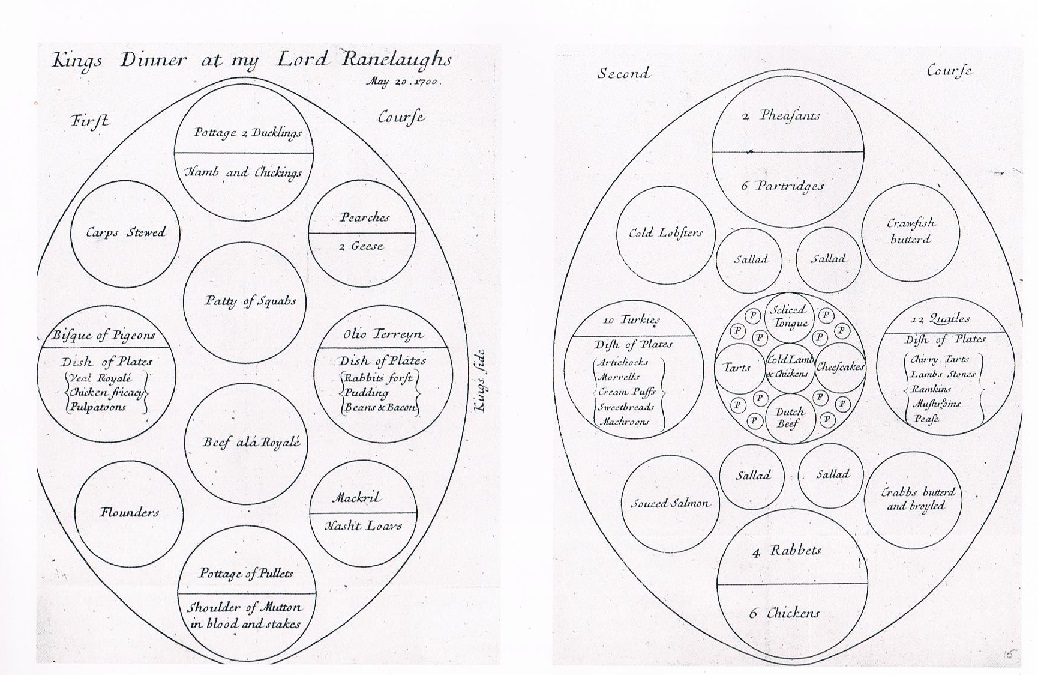 Although fashions changed, in its overall form service à la française remained the standard for formal dining until almost the end of the nineteenth century. It probably ended because even the grandest host could no longer maintain the enormous number of servants required to get all the dishes to the table at the same time, and then only to watch everything going cold before the diners finally managed to get round to sampling it. This is 'A State Party' by Richard Doyle, from 'Birds Eye View of Society' (1864) which depicts, albeit somewhat satirically, a fairly grand society dinner à la française. The meal is for just a dozen people but there are seventeen servants depicted attending the table (compare that to the number of serving staff in a modern busy restaurant) and that's in addition to all the kitchen staff slaving away below stairs. The cartoon also mocks the very Victorian fashion of having the host carve the principal roast joint, often with great difficulty on a table crammed with food, flowers and candelabra, while the guests looked on expectantly as the rest of the food went cold. 
Last edited by Meles meles on Sun 29 Dec 2019, 17:38; edited 5 times in total (Reason for editing : typos) |
|   | | PaulRyckier
Censura

Posts : 4902
Join date : 2012-01-01
Location : Belgium
 |  Subject: Re: Dish of the Day - II Subject: Re: Dish of the Day - II  Sat 28 Dec 2019, 23:33 Sat 28 Dec 2019, 23:33 | |
| MM and LiR, MM I thank you for this detailed and excellent answer to my question. I just entered now but had before already read all the new comments on the site. I wanted for the second time in two days comment all the interesting messages from you and LiR, but again at the end of the evening stuck in a reply to Narduccio on the Passion Histoire: "Why is it so difficult to discuss certain events?" http://geopolitique.passion-histoire.net/viewtopic.php?f=10&t=1364&sid=762d3668169cbe3dc1fc889104c71b30&start=20And I have to be a bit careful  in composing my message as he seems to be the boss or one of the bosses of the place... To be honest, to compose such messages as yours overhere and on the dollar thread I need certainly two hours, because of the English language and the search for sources. With esteem for your excellent messages. Kind regards, Paul. |
|   | | Meles meles
Censura

Posts : 5079
Join date : 2011-12-30
Location : Pyrénées-Orientales, France
 |  Subject: Re: Dish of the Day - II Subject: Re: Dish of the Day - II  Sun 26 Jan 2020, 14:20 Sun 26 Jan 2020, 14:20 | |
| 26 January 1788 - the so-called First Fleet finally made permanent landfall at Sydney Cove in the 'newly-discovered' land of Australia. Accordingly today marks the formal beginning - whether for good or ill - of the modern nation of Australia. The date, 26th January, has been marked ever since as Australia Day ... although nowadays with increasing controversy. So for today I'll just post the following recipe which is taken from a lovely little charity cookbook compiled by the 'Women’s Auxiliary for the Royal Flying Doctor Service'. The book is undated but looks to be from the late 50’s, or perhaps 60's.  Early Settler’s Birthday Cake. Early Settler’s Birthday Cake.
Cream 2 cups dripping with 2 cups sugar. Add 1 emu egg, beating well. Flavour with vanilla.
Sift two teaspoons soda and 4 teaspoons cream of tartar with 6 cups flour. Add this a little at a time alternately with 2 cups milk. Add 2 cups currants.
Bake in 3 large tins in moderate oven.
Hmm .... a single emu egg would, I think, be about equal to ten chickens' eggs. Okay. But the recipe then begs the question: was the suggested emu egg expected to be gathered from the wild, or bought from a local store? Emus are large, powerful, often aggressive birds, who are well able to defend their nests... so a wild-gathered emu egg seems a rather unlikely ingredient for general use. Were emus ever farmed for their eggs? I've never seen any suggestion that they were, but I suppose it's not impossible: certainly ostriches (close relatives of emus) are now farmed ... but that's always for their meat. So perhaps it really was always just a joke.
Last edited by Meles meles on Sun 26 Jan 2020, 17:58; edited 1 time in total |
|   | | Vizzer
Censura

Posts : 1814
Join date : 2012-05-12
 |  Subject: Re: Dish of the Day - II Subject: Re: Dish of the Day - II  Sun 26 Jan 2020, 17:57 Sun 26 Jan 2020, 17:57 | |
| That is indeed an odd recipe. It seems that they were just trying to get an emu egg into the list of ingredients as some kind of 'Australian' token. Other than that it reads as a sort of currant pound cake. The give away seems to be the last line which says 'bake in 3 large tins'. So that's 3 birthday cakes then. |
|   | | Meles meles
Censura

Posts : 5079
Join date : 2011-12-30
Location : Pyrénées-Orientales, France
 |  Subject: Re: Dish of the Day - II Subject: Re: Dish of the Day - II  Tue 25 Feb 2020, 11:34 Tue 25 Feb 2020, 11:34 | |
| Yesterday was the Monday before Shrove Tuesday, and in Northern England it was often widely known as Collop Monday, on which day collops (thinnish slices of meat or bacon) are the traditional dish.
Daniel Defoe's 'Tour of Great Britain' of 1726 has, "The Monday preceding Fastens Even, called everywhere in the North Collop Monday, from an immemorial Custom there of dining that Day on Eggs and Collops."
John Brand, a Fellow with the Society of Antiquaries of London, in his 'Observations on popular antiquities of Great Britain' (1849), recorded; "It should seem that on Collop Monday they took their leave of flesh in the papal times, which was anciently prepared to last during the winter by salting, drying and being hung up. Slices of this kind of meat are to this day termed collops in the north, whereas they are called steaks when cut off from fresh or unsalted flesh".
The Nottingham Evening Post for Saturday 1 March 1924 has; "Collop Monday, the day before Shrove Tuesday, is so-called because our ancestors cut their fresh meat into collops or steaks for salting or hanging up till Lent was over. Yorkshire and many other places it is still a custom to have eggs and collops or slices of bacon at dinner this day."
The York Herald for Saturday 29 February 1896 has; "Collop Monday is the day before Shrove Tuesday. It has little or no significance now. It is, however, still remembered mostly by school children, into whose keeping not a few of the once famous days of our ancestors seem to have fallen. Just as on Shrove Tuesday there is a dish of pancakes in not a few northern homes, so on Collop Monday it was customary a generation ago to have a dish of collops of bacon, with eggs, on this day. That was especially the case a generation or so ago in Yorkshire, Lancashire, and Durham. At one time, too, long prior to the advent of School Boards, the children in these counties used to go fom door to door singing,
To-day is Collop Monday,
Gie's a collop, an' let's away.
The origin of the day, however, lies in the fact that at this time our ancestors were in the habit of cutting their meat into strips or collops, so that it might be salted and hung up, and so preserved during Lent."
Collops could be of any type of meat, so for today here's an old recipe for beef collops, from Hannah Glasse's book, 'The Art of Cookery, Made Plain and Easy' (1747).
Beef collops
CUT them into thin pieces about two inches long, beat them with the back of a knife very well, grate some nutmeg, flour them a little, lay them in a stew-pan, put in as much water as you think will do for sauce, half an onion cut small, a little piece of lemon-peel cut small, a bundle of sweet-herbs, a little pepper and salt, a piece of butter rolled in a little flour. Set them on a slow fire: when they begin to simmer, stir them now and then; when they begin to be hot, ten minutes will do them, but take care they do not boil. Take out the sweet-herbs, pour it into the dish, and send it to table.
She then added an interesting little note to the end of this recipe.
Note; You may do this dish between two pewter dishes, hang them between two chairs, take six sheets of white brown paper, tear them into strips, and burn them under the dish one piece at a time.
What she meant by this is not entirely clear although she gives more advice about the brown paper method in another recipe elsewhere in her book:
... hang the dish on the back of two chairs by the rim, have ready three sheets of brown paper, tear each sheet into five pieces and draw them through your hand; light one piece and hold it under the bottom of the dish moving the paper about; as fast as the paper burns light another till all is burnt and your meat will be enough. Fifteen minutes just does it.
It's a novel cooking technique although I'm not convinced it would give enough heat, but I suppose thin beef slices do not need much cooking and can be eaten very rare. |
|   | | Meles meles
Censura

Posts : 5079
Join date : 2011-12-30
Location : Pyrénées-Orientales, France
 |  Subject: Re: Dish of the Day - II Subject: Re: Dish of the Day - II  Tue 25 Feb 2020, 17:34 Tue 25 Feb 2020, 17:34 | |
| Today is Shove Tuesday, Pancake Day, the last day before the 40-day Lenten fast begins tomorrow. Accordingly it is often suggested that English Shrovetide pancakes were formerly rather grand confections, made to use-up all those forbidden foods. But this seems rather odd as late winter is not a time when there are surplus perishable foods around and there is no evidence at all for such a dish. Indeed traditional Shrove Tuesday pancakes are made entirely of ingredients generally permitted during the fast (except eggs, which at various times the church in England did frown upon). In any case, while abstinence during Lent, to promote self-discipline and heighten spiritual awareness, is a tradition enjoined by the Church since ancient times, it has always been left to the individual to decide precisely what they should abstain from.
The usual story, here from the 1815 'Clavis Calendaria; or, A compendious analysis of the calendar' by John Brady, is that the tradition comes from; "the ancient practice of shriving or confessing [where] prior to the Reformation every communicant throughout the kingdom was obliged individually to confess to his parish priest. ... After the people had made the confession required at this season by the discipline of the ancient church they were permitted to indulge in festive amusements although not allowed to partake of any repasts beyond the usual substitutes for flesh. Hence arose the custom yet preserved of eating Pancakes and Fritters at Shrovetide which has given this day the vulgar appellation of Pancake Tuesday while it is to be remembered that the Monday preceding this day was by the vulgar called Collop Monday a name it even yet retains in some places from the primitive custom of regaling with eggs."
Another story is that Pancake Day began with Sir Simon Eyre, who, on becoming Lord Mayor of London in 1445 celebrated his own humble beginnings as a craftsman by inviting all the apprentices of the city to a luncheon. The day was Shrove Tuesday, and pancakes happened to be served, which, in gratitude for the much-needed day off, the apprentices continued annually as a tradition.
Anyway whatever the origin, the traditional Shrove Tuesday fare in England is pancakes. So here's an early recipe from that dour old puritan Gervase Markham's 'The English Huswife' (1615) - spice aside, they’re pretty dull things; rubbery and heavy. Cream may be taking things too far, but some milk is surely a must.
THE BEST PANCAKES.
To make the best Pancakes, take two or three Eggs, and break them into a dish, and beat them well; then add unto them a pretty quantity of fair running Water, and beat all well together: then put in Cloves, Mace, Cinnamon and Nutmeg, and season it with Salt; which done, make it as thick as you think good with fine Wheat-flower, then fry the Cakes as thin as may be with sweet butter, or sweet seam, and make them brown, and so serve them up with Sugar, strewed upon them. There be some which mix Pancakes with new Milk or Cream, but that makes them tough, cloying, and not so crisp, pleasant and savory as running water.
Or for a more modern-style pancake here's a recipe from Charles Elme Francatelli's 'A Plain Cookery Book for the Working Classes' (1846):
PANCAKES FOR SHROVE TUESDAY.
Ingredients, twelve ounces of flour, three eggs, one pint of milk, a tea-spoonful of salt, a little grated nutmeg, and chopped lemon-peel. First, put the flour into a basin, hollow out the centre, add the salt, nutmeg, lemon-peel, and a drop of milk, to dissolve them; then break in the eggs, work all together, with a spoon, into a smooth soft paste, add the remainder of the milk, and work the whole vigorously until it forms a smooth liquid batter. Next, set a frying-pan on the fire, and, as soon as it gets hot, wipe it out clean with a cloth, then run about a tea-spoonful of lard all over the bottom of the hot frying-pan, pour in half a small tea-cupful of the batter, place the pan over the fire, and, in about a minute or so, the pancake will have become set sufficiently firm to enable you to turn it over in the frying-pan, in order that it may be baked on the other side also; the pancake done on both sides, turn it out on its dish, and sprinkle a little sugar over it: proceed to use up the remaining batter in the same manner.
... although personally my usual topping is whatever's on the floor when I try to flip the pancakes. |
|   | | PaulRyckier
Censura

Posts : 4902
Join date : 2012-01-01
Location : Belgium
 |  Subject: Re: Dish of the Day - II Subject: Re: Dish of the Day - II  Tue 25 Feb 2020, 20:17 Tue 25 Feb 2020, 20:17 | |
| |
|   | | Meles meles
Censura

Posts : 5079
Join date : 2011-12-30
Location : Pyrénées-Orientales, France
 |  Subject: Re: Dish of the Day - II Subject: Re: Dish of the Day - II  Wed 26 Feb 2020, 08:53 Wed 26 Feb 2020, 08:53 | |
| - PaulRyckier wrote:
- It seems ot be every where in the "Christian" lands the last day of Carnival.
I wondered about the Muslim and Jewish equivalents, making with the Christians together the Abrahamic religions.
On the first sight no equivalent there to the Christian "carnival"? Neither in Muslim nor in Jewish religion?
In Lebanon there's Khamis el sakara, خميس السكارى, or Drunken Thursday - celebrated on the last Thursday before Lent, (or now probably more practically on the last Saturday night). In the Catholic church the Thursday before Lent is a specific day of remembrance for the dead, however zakara, meaning 'remembrance' in Lebanese Arabic, has gradually morphed into sakara, meaning 'drunkeness'. In Lebanon khamis el sakara is of course a tradition rather than a religious rite and is basically just an evening to have a good meal and get drunk with friends while remembering those who can't be with you. At heart it is still a tradition associated with Lebanese Christians rather than Muslims, although everyone is welcome to join in. In that regard it is perhaps somewhat like the Baklahorani festival (Μπακλαχοράνι, in Greek); a carnival celebrated annually in Istanbul by members of the Greek-Orthodox community on Shrove Monday, the last Monday before Lent. Again, like khamis el sakara, although led by the local Christians, it has generally been celebrated by the wider community (unless banned outright by the authorities). Ramadan is of course rather different to Lent in that although the fasting period also lasts a month, each day's fast only lasts between sunrise and sunset, and is broken every evening by a communal meal, iftar, which is often a lavish banquet, followed by another pre-dawn meal, suhur, before fasting begins again. |
|   | | PaulRyckier
Censura

Posts : 4902
Join date : 2012-01-01
Location : Belgium
 |  Subject: Re: Dish of the Day - II Subject: Re: Dish of the Day - II  Wed 26 Feb 2020, 19:39 Wed 26 Feb 2020, 19:39 | |
| MM, I am glad that you mentioned Lebanon, that melting pot of cultures and religions. And I agree there was a civil war, but somewhere the old spirit of before the war is still present as for instance this quarter in Beirout https://www.latimes.com/archives/la-xpm-2008-may-19-fg-lebanon19-story.htmlFrom the link: Unlike the rest of Lebanon, Beirut’s Hamra Street doesn’t belong to Sunni or Shiite or Christian or Druze. In a Middle East characterized by extremes of poverty and wealth, radical Islamic fundamentalism and compulsive Western-style consumerism, decrepit slums and gated Persian Gulf fortresses, Hamra Street stands out. Kind regards, Paul. |
|   | | LadyinRetirement
Censura

Posts : 3301
Join date : 2013-09-16
Location : North-West Midlands, England
 |  Subject: Re: Dish of the Day - II Subject: Re: Dish of the Day - II  Fri 28 Feb 2020, 14:43 Fri 28 Feb 2020, 14:43 | |
| Do you ever cook any of these wonderful meals for your guests at the guesthouse, MM? Not the birds within birds within birds fare of course. My brother's wife is from Colombia (as in the South American country) though her father came from Lebanon originally and her mother from Spain. Her father predeceased her mother by some years and when I asked her she said she had either lost touch with relatives in Lebanon or they were deceased. As far as I can tell she cooks in the English fashion for my brother though that may vary when they visit Colombia.
Now that I have a microwave oven again I can perhaps start being a little more adventurous with my attempts at cooking. |
|   | | Nielsen
Triumviratus Rei Publicae Constituendae

Posts : 595
Join date : 2011-12-31
Location : Denmark
 |  Subject: Re: Dish of the Day - II Subject: Re: Dish of the Day - II  Fri 28 Feb 2020, 15:42 Fri 28 Feb 2020, 15:42 | |
| - LadyinRetirement wrote:
- Do you ever cook any of these wonderful meals for your guests at the guesthouse, MM?
...
Now that I have a microwave oven again I can perhaps start being a little more adventurous with my attempts at cooking. I'd like to know that as well, Mm, if you do I should seriously consider re-newing my passport and start asking questions about accessibility on the way down - and back, knowing that that at all cost I must avoid the month of August. ... LiR, Since I moved I have, for the first time in my life acquired a microwave, so far it hasn't made my cooking more adventurous, it's just made me more lazy. |
|   | | PaulRyckier
Censura

Posts : 4902
Join date : 2012-01-01
Location : Belgium
 |  Subject: Re: Dish of the Day - II Subject: Re: Dish of the Day - II  Fri 28 Feb 2020, 19:01 Fri 28 Feb 2020, 19:01 | |
| Nielsen and LiR, interested in your good intentions and my question to MM is also the same as yours. And yes if it wasn't the question of accessibility for the partner that I have to guide, I would consider the same as you (although the partner only understand Dutch...) You said "re-newing my passport". May I presume that you haven't a Danish indentity card and can't go freely to France...? OOPS, now I see https://en.wikipedia.org/wiki/National_identity_cards_in_the_European_Economic_AreaIceland, Norway, Denmark, Ireland have no identity cards. That of Ireland I knew already from my research in the time for the "Brexit" debate. PS: Why do they always say "micro- wife" and not "micro-man". Is that indeed because men are more lazy than women? I do the cooking in house and use regularly the microwave as it is a good alternative for gas when making stew. The same for heating quickly a glass of liquid...I don't say that the electricity of the microwave isn not more expensive than the gas-cooking... PPS: I have still butane gas for cooking and it is much cheaper than the distributed earth gas by the network company that I have for heating of the house... Before it was an electrical oven but my partner in the time didn't want an electrical and so when we changed to gas, we could only do it with butane in a bottle as I had no connection with the gasinstallation in the garage and the kitchen and the cost to make a connection throughout the house was too high... PPPS: after more than 30 years I have now to replace the old one...and the hole of the old plate is too large to install the new standard square 60cm on 60 cm) so I had to buy an special broader plate, which was not so cheap as the standard one...and a new connection to the butane bottle, which is also not standard... Kind regards to both of you from Paul. |
|   | | Meles meles
Censura

Posts : 5079
Join date : 2011-12-30
Location : Pyrénées-Orientales, France
 |  Subject: Re: Dish of the Day - II Subject: Re: Dish of the Day - II  Sat 29 Feb 2020, 12:16 Sat 29 Feb 2020, 12:16 | |
| - LadyinRetirement wrote:
- Do you ever cook any of these wonderful meals for your guests at the guesthouse, MM?
Sometimes, but not very often. Strictly I'm just a b&b, not a restaurant, and not registered for food preparation (other than simple breakfast etc) however I do cook on occasion when the local restaurants are closed, or people are arriving late (I always have stuff in stock if necessary) and I have done full four-course meals when people have specifically asked in advance. The trouble is that if I offer dinner to one couple, I really have to offer it to everyone, and so I have to have enough stuff in stock to maybe feed eight or even ten people. There again very often guests prefer to go to the local restaurant (where there's a choice and local specialities), or have already eaten en-route, or have come prepared to picnic in the garden, or have plans to meet with friends etc. When I do cook I tend to do standard French rustic staples like coq au vin, boeuf bourguignon, poulet basquaise, carbonade à la flamande, gratin dauphinoise, ratatouille, salad niçoise, tian provençale, tarte aux pommes etc, all of which are either fairly quick to do or can be largely prepared in advance. Hence I generally have several tubs of coq au vin, ratatouille, and vegetarian mild Thai aubergine curry, already made in advance and frozen down in the freezer, and I always try to have enough ingredients in stock to quickly whip up a salad, an omelette or some Scottish cranachan if necessary. I once did beef Wellington on the anniversay of the battle of Waterloo (18 June) and have done poulet à la catalane on Catalan National Day (11 September). I quite often try out old recipes, such as the things posted here, but usually only for my own interest, although they might subsequently become part of my repertoir. I'm trying to extend my range of local Catalan dishes as generally French people are interested in food and sampling local specialities, although I'm wary in case they are local to here and know how a dish should properly be done. I was also once asked to prepare a 'typically English' meal - I did steak and kidney pudding followed by blackberry and apple crumble served with custard - and a couple of times have done what I called Sussex Chicken, after one of my mother's recipes, and which, being similar to poulet normande, is not too alien for conservative French palates. |
|   | | Meles meles
Censura

Posts : 5079
Join date : 2011-12-30
Location : Pyrénées-Orientales, France
 |  Subject: Re: Dish of the Day - II Subject: Re: Dish of the Day - II  Sat 29 Feb 2020, 17:12 Sat 29 Feb 2020, 17:12 | |
| 30 February 1712 - the only time when the month of February has had 30 days, and only in Sweden and Finland, the latter then being part of the Swedish kingdom. The Gregorian calendar was introduced by Pope Gregory XIII by papal bull in October 1582 as a correction to the old Julian calendar. By the new Gregorian calendar the average year was shortened by 0.0075 days to stop the drift of the calendar with respect to the equinoxes. To deal with the 10 days' difference (between calendar and reality) that this drift had already reached, the date was advanced so that 4 October 1582 was followed by 15 October 1582, but there was to be no discontinuity in the cycle of weekdays. The reform also altered the lunar cycle used by the Church to calculate the date for Easter, restoring it to the time of the year as originally celebrated by the early Church. By the Gregorian calendar leap years are spaced to make the average year 365.2425 days long, approximating the 365.2422-day tropical year that is determined by the Earth's revolution around the Sun. The rule for leap years is: every year that is exactly divisible by four is a leap year, except for years that are exactly divisible by 100, but these centurial years are leap years if they are exactly divisible by 400. Although Gregory's reform was enacted in the most solemn of forms available to the Church, the bull had no authority beyond the Catholic Church and the Papal States. The changes that he was proposing were changes to the civil calendar, over which he had no authority and so they required adoption by the civil authorities in each country to have any legal effect. In September 1582, Philip II of Spain decreed the change from the Julian to the Gregorian calendar throughout his realms. This affected much of Roman Catholic Europe as Philip was at the time ruler over Spain and Portugal as well as much of Italy. In these territories and in the Papal States, the new calendar was implemented on the date specified by the bull, with Julian Thursday, 4 October 1582, being followed by Gregorian Friday, 15 October 1582. Many Protestant countries, however, initially objected to adopting a Catholic innovation and continued to use the Julian calendar for some time. For example, Britain and the British Empire (including the eastern part of what is now the United States) only adopted the Gregorian calendar in 1752. Sweden followed the next year but it had already tried to align it's calendar some years earlier, an attempt that led to it experiencing a unique date: 30 February 1712. In November 1699 the Government of Sweden had decided that, rather than adopt the Gregorian calendar outright, it would gradually approach it over a 40-year period. The plan was to skip all leap days in the period 1700 to 1740 so that every fourth year, the gap between the Swedish calendar and the Gregorian would reduce by one day, until they finally lined up in 1740. In the meantime however this calendar would not be in line with either of the major alternative calendars and the differences would change every four years. In accordance with the plan, February 29 was omitted in 1700, but the subsequent leap days for 1704 and 1708 were inserted in error by the Swedish almanac makers (in part due to the the turmoil of the Great Northern War) thus bringing the Swedish calendar one day out of step with the Julian calendar and 10 days out of step with the Gregorian calendar. In order to end this calendar confusion, it was decided in 1710 to revert back to the original Julian calendar by adding an extra second leap day (30 February) into the next leap year, 1712, thus creating a unique month that had never happened before and has not occurred since. Here is a Swedish almanac for 1712 showing the 30 days of February.  So to celebrate leap years generally and in particular Sweden's unique double leap in February 1712, how about some cake? I wish I could have found something Swedish, but this one, from the 'Australian Women’s Weekly' (15 February, 1936) will have to do. Leap Year Cake.
One pound dates, 1lb. currants, 1lb. sultanas, 1lb. chopped almond, 1 tablespoon preserved ginger (cut fine), ½ lb. sugar, 2 tablespoons golden syrup, 3 eggs, ¾ lb. butter, 1 ¼ lb. plain flour, 1 teaspoon carb. soda, a little nutmeg.
Cream butter and sugar, add eggs, one at a time, and mix in golden syrup. Then mix in plain flour (to which carb. soda and nutmeg have been added), and lastly add fruit and nuts cut fine (if desired). Bake in a slow oven for 3 hours. This cake will keep for six months.And to wash it down maybe a glass of Leap Year Cocktail. This is taken from 'The Savoy Cocktail Book' (1930) which states, "This Cocktail was created by [head barman] Harry Craddock for the Leap Year celebrations at the Savoy Hotel, London, on February 29th, 1928. It is said to have been responsible for more proposals than any other cocktail that has ever been mixed."Leap Year Cocktail
Ingredients:
2 ounces gin
1/2 ounce Grand Marnier
1/2 ounce sweet vermouth
1 dash fresh lemon juice
Directions:
Pour ingredients into a cocktail shaker and fill with ice. Shake well for 10 seconds and strain into a chilled cocktail glass. Twist a piece of lemon peel over the drink and use for garnish. |
|   | | Meles meles
Censura

Posts : 5079
Join date : 2011-12-30
Location : Pyrénées-Orientales, France
 |  Subject: Re: Dish of the Day - II Subject: Re: Dish of the Day - II  Sun 01 Mar 2020, 16:21 Sun 01 Mar 2020, 16:21 | |
| As LiR has pointed out today is St David's Day, so...
1 March 589 (traditional date) - St David, or just David/Dewi of Wales as he was known during his life, died peacefully at the monastery of Mynyw in Dyfed (now called after him St Davids or Tyddewi in Welsh). St David led his monks by example, living a simple life of asceticism: he and his monastic followers pulled the plough themselves without draught animals, drank only water, and ate no meat but only bread and vegetables seasoned with just salt and local herbs. Accordingly as well as being the patron saint of Wales he's also the patron of vegetarianism.
His symbol - also an emblem of Wales along with the red dragon, y Ddraig Goch, and the daffodil, or St Peter's leek, cenhinen Bedr as it's known in Welsh - is the common leek, and this inspired a reference in Shakespeare's Henry V, Act V scene 1:
Fluellen: If your Majesty is remembered of it, the Welshmen did good service in a garden where leeks did grow, wearing leeks in their Monmouth caps, which your Majesty knows, to this hour is an honourable badge of the service, and I do believe, your Majesty takes no scorn to wear the leek upon Saint Tavy's day.
King Henry: I wear it for a memorable honour; for I am Welsh, you know, good countryman.
So I guess a very simple leek soup, or cawl cennin in Welsh, thickened only with potato or flour and seasoned with just salt, would be a suitable dish of the day. |
|   | | LadyinRetirement
Censura

Posts : 3301
Join date : 2013-09-16
Location : North-West Midlands, England
 |  Subject: Re: Dish of the Day - II Subject: Re: Dish of the Day - II  Tue 03 Mar 2020, 09:16 Tue 03 Mar 2020, 09:16 | |
| In a couple of weeks (roughly) it will be St Patrick's* Day - and my birthday - so I'm giving you sufficient notice to prepare a nice gluten-free cake, MM.
Joking aside, because I have to watch my blood pressure (I take a tablet for the condition daily) I have to be careful over salt and sugar consumption and cakes are not advised by the GP. There is fresh fruit as an option though of course that has some sugar content.
*I've a memory of nordmann saying one year that St Patrick wasn't a historical entity or was a composite of various people - or something like that; I'm sure I'll be notified if I've misremembered. (I've been visiting the board since 2013 - time flies when you're having fun). |
|   | | Meles meles
Censura

Posts : 5079
Join date : 2011-12-30
Location : Pyrénées-Orientales, France
 |  Subject: Re: Dish of the Day - II Subject: Re: Dish of the Day - II  Thu 19 Mar 2020, 10:22 Thu 19 Mar 2020, 10:22 | |
| Yesterday... 18 March 1944 - the most recent major eruption of Vesuvius. After the previous major eruption in 1906, Vesuvius had rumbled on, quietly and intermittently, until 1944. Then on 13 March 1944 a side cone collapsed forming a depression of about 20 m depth, whilst there were also several small volcanic explosions. This new activity was followed on 18 March (at 16.30 local time) by a sudden violent explosion which was soon accompanied by an eruption of lava from within the crater that rapidly overflowed the north side of the crater wall, and so by late that evening there were several lava streams coming down the mountain from the main cone. On the following day, 19 March, these flows reached the first houses of the villages of San Sebastiano al Vesuvio, Massa di Somma, and Ottaviano, all three located only a kilometre or two from the mountain. Over the following few days these villages, as well as a part of San Giorgio a Cremano, were almost completely destroyed by the lava flows. A lava fountain started on 21 March and this developed into a sustained ash plume which reached at altitude of about 5 km above the crater rim and was clearly visible over the whole region. Finally on 27 March the explosions started to become less frequent and less violent, and on 29 March the eruption ended. The eruption of Vesuvius in 1944 occurred six months after the liberation of Naples by allied troops: with its large port and airfields the city was a major strategic base in the continuing fight against German forces in Italy. The United States Army Air Forces (USAAF) 340th Bombardment Group was based at Pompeii Airfield near Terzigno, just a few kilometres from the eastern base of the volcano, and about eighty of their aircraft were destroyed by falling hot ash, although the presence of many USAAF reconnaisance photographers did at least mean that the eruption was well recorded for posterity. Overall there were very few casualities from the eruption itself but the economic loss from the destruction of the villages and the damage to military equipment was significant.   The city of Naples with Vesuvius erupting behind, and as photographed from a US bomber, March 1944. So to mark the event it's got to be the Italian-American dish, Chicken Vesuvio. This is a specialty of Chicago, made from chicken on the bone, and, rather unusually for an Italian-style dish, potatoes rather than pasta, which rather suggests it isn't closely based on any authentic Neapolitan recipe. The chicken and wedges of potato are sautéed with garlic, oregano, white wine, and olive oil, then baked until the chicken's skin becomes crisp. The dish is then finally garnished with a few green peas, green beans or artichoke hearts to add some colour. It seems to have first appeared, at least in print, shortly after World War II and it is tempting to think that the dish was created by an American servicemen, who had served in Italy, on his return to civillian life in the States. However it has also been suggested that it might have been popularized by the Chicago's 'Vesuvio Restaurant' which operated during the 1930s (ie pre-war). Others have speculated that the name derives either from the amount of smoke produced in the cooking process when the wine is added to the hot pan, or that by heaping up the steaming chicken in the middle and arranging potato wedges upright around it, the completed dish resembles the pyramidal cone of mount Vesuvius. One of the earliest print references to Chicken Vesuvio is from the 'Chicago Daily Tribune' (August 21, 1948): Last week in Chicago a new and unique organization joined the ever growing list of wine and food societies in this country. While the name adopted is somewhat jocose - the Streeterville and Sanitary Canal Gourmet and Study Society - its purpose is admirable. ...
The main entry was Chicken Vesuvio. Cut a chicken into small serving pieces and fry in pure olive oil. In the meantime, cut large potatoes into oversize french fry slices, and deep fry them in lard until almost cooked. When the chicken is nearly done, add the potatoes to the chicken, sprinkle salt and freshly ground pepper to taste, a small pinch of ground red chili peppers, and a small pinch of oregano over the contents of the pan. Stir the mixture gently, then place a cover on the pan and let cook for about 2 or 3 minutes. Place everything on a hot serving platter, sprinkle over the whole a liberal portion of finely chopped parsley, and serve. [I note the potatoes are fried in lard - hardly very southern Italian but then Chicago was a major pork processing city. And there's no garlic either!]. By the 1960s the original concept of "chicken and fried potatoes" had evolved into an elaborate gourmet procedure as professional American chefs decided they needed to validate a simple home-grown dish to make it more "Italian". They added grated cheese, cream, paprika, chilli powder, monosodium glutamate and other unspeakable ingredients, but none of these are necessary, nor indeed are they typically Italian. Modern recipes, such as those widely available online, thankfully tend to be closer to the "original" simple "chicken and chips" recipe ... whatever that might actually be.  Chicken Vesuvio. |
|   | | Meles meles
Censura

Posts : 5079
Join date : 2011-12-30
Location : Pyrénées-Orientales, France
 |  Subject: Re: Dish of the Day - II Subject: Re: Dish of the Day - II  Tue 31 Mar 2020, 08:31 Tue 31 Mar 2020, 08:31 | |
| 31 March 1889 – The Eiffel Tower is officially opened. After discussions in the press about a suitable centrepiece for the proposed 1889 Paris Exposition Universelle (Universal Exhibition) - a world's fair to celebrate the centennial of the Storming of the Bastille and the start of the French Revolution - two engineers working at Compagnie des Établissements Eiffel, Maurice Koechlin and Émile Nouguier, set about designing "a great pylon, consisting of four lattice girders standing apart at the base and coming together at the top, joined together by metal trusses at regular intervals". Gustave Eiffel himself initially showed little enthusiasm for the project but he did approve further study. With the involvement of the head of the company's architectural department, Stephen Sauvestre, the design was modified to include a large glass pavilion on the first level, plus other embellishments. The new version gained Eiffel's support and the design was exhibited at the Exhibition of Decorative Arts in the autumn of 1884 under the company name. On 30 March 1885, Eiffel presented his plans to the Société des Ingénieurs Civils, and after discussing the technical problems and emphasising the practical uses of the tower, he finished his presentation by saying the tower would symbolise, "... not only the art of the modern engineer, but also the century of Industry and Science in which we are living, and for which the way was prepared by the great scientific movement of the eighteenth century and by the Revolution of 1789, to which this monument will be built as an expression of France's gratitude."
 A caricature of Eiffel with his tower, comparing it to the Egyptian pyramids ('Le Temps', 14 février 1887). But little progress was made until 1886, when Jules Grévy was re-elected as president of France and Édouard Lockroy was appointed as minister for trade. A budget for the Universal Exhibition was passed and, on 1 May, Lockroy announced an alteration to the terms of the open competition being held for a centrepiece to the Exhibition. This effectively made the selection of Eiffel's design a foregone conclusion, as entries had to include a study for a 300 m (980 ft) four-sided metal tower on the Champ de Mars, and a 300-meter tower was then considered a herculean engineering effort. On 12 May a commission was set up to examine Eiffel's scheme and its rivals, which, a month later, decided that all the proposals except Eiffel's were either impractical or lacking in details. After some debate about the exact location of the tower, a contract was signed on 8 January 1887 and construction started later that same month. The foundations were completed on 30 June and assembly of the iron parts fabricated in Eiffel's factories at Levallois-Perret, an industrial suburb downriver from Paris, began the following day. By 1 April 1888 the first floor had been completed; the second followed on 14 August; and on 15 March the crowning cupola was completed. The tower was officially opened on 31 March 1889, five weeks ahead of the Exhibition's opening. But even as the tower rose upward, a chorus of opposing voices rose in protest, attacking it as a meaningless gesture, devoid of function and too reminiscent of an industrial chimney. A petition called "Artists against the Eiffel Tower" was sent to the Minister of Works and Commissioner for the Exposition, Adolphe Alphand, and it was published by 'Le Temps' on 14 February 1887: "We, writers, painters, sculptors, architects and passionate devotees of the hitherto untouched beauty of Paris, protest with all our strength, with all our indignation in the name of slighted French taste, against the erection … of this useless and monstrous Eiffel Tower … To bring our arguments home, imagine for a moment a giddy, ridiculous tower dominating Paris like a gigantic black smokestack, crushing under its barbaric bulk Notre Dame, the Tour Saint-Jacques, the Louvre, the Dome of les Invalides, the Arc de Triomphe, all of our humiliated monuments will disappear in this ghastly dream. And for twenty years … we shall see stretching like a blot of ink the hateful shadow of the hateful column of bolted sheet metal."Some of the protesters subsequently changed their minds when the tower was built but others remained unconvinced: Guy de Maupassant supposedly ate lunch in the tower's restaurant every day because it was, as he said, the one place in Paris where the tower was not visible. Nevertheless the tower soon became a (generally) well-loved symbol of Paris and of France. For the 1889 Exhibition there were four pavilions on the platform of the first floor of the Eiffel Tower, each containing a restaurant and with the kitchens being located underneath. On the River Seine side of the tower was 'Le Flamand' restaurant that, somewhat bizarrely given its name, specialised in French cuisine from the Alsace region of France with its waitresses in regional clothing; on the opposite, Champ de Mars side, there was 'Le Brébant' restaurant serving classically French cuisine (and operated by a well-established Parisian restaurant of the same name close to the Opéra Garnier in the 9e arrondissement); whilst on the other two sides there was a Russian-style restaurant and an Anglo-American bar. 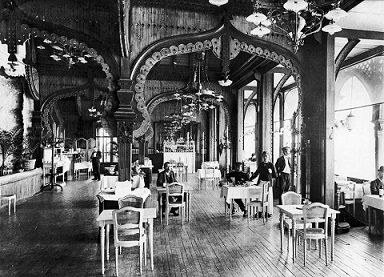 One of the Eiffel Tower's restaurants in 1889. 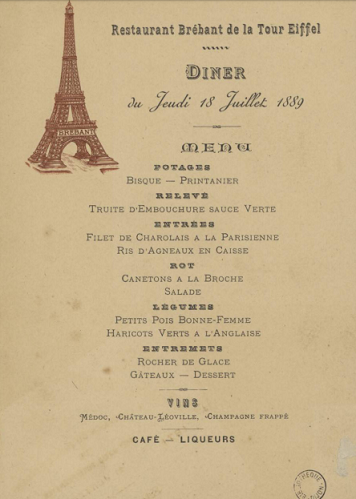 A menu from the Eiffel Tower's 'Brébant' restaurant during the 1889 Exhibition. After the Exhibition the 'Flamand' was turned into a theatre, then became a Dutch restaurant for a short period of time for the 1900 exhibition, before it was returned to a theatre until the First World War. The other three restaurants remained, although with some interior changes, until 1937 when all four of the original restaurants were demolished in preparation for the 1937 International Exhibition. With the complete overhaul and refurbishment of the first floor of the Eiffel Tower for this occasion, it was decided that there would now only be two restaurants, the first being where the Russian restaurant was located and the second where the Dutch restaurant and theatre used to be. These two restaurants were called 'La Belle France' and 'Le Parisien' until 1966 when, during a major renovation of the whole tower, they were transformed into one large brasserie named 'Altitude 95' due to it being located 95 metres above sea level. The now famous 'Jules Verne' restaurant on the second platform was only constructed in 1983 with the name chosen to honour the literary master who was also a champion for scientific and industrial progress, as exemplified by the Eiffel Tower itself. During the construction it was decided that this privileged gourmet restaurant would have its very own elevator to be used exclusively by its customers, and this is where Macron entertained Trump after the Bastille Day parade in 2017. Needless to say, the 'Jules Verne' is rather exclusive and accordingly very expensive, although the view, at least outside, is very nice.  Le soir du 14 juillet 2017 dans le 'Jules Verne' Having had a look at the 'Jules Verne' restaurant's website, I can report that, although obviously closed just at present, they currently do a three course lunch menu available Monday to Friday with things such as half-smoked salmon, sour cream, lemon and dill, followed by a main course like roast duck with foie gras and turnip confit, then dessert, which costs €135 (there is also an a la carte menu available). For dinner there are five- and seven-course tasting menus at €190 and €230, consisting of such sumptuous delights as scallops with lime zest and caviar, langustine raviolli with celeriac cream and black truffle, or roast venison with a poivrade sauce - all very yummy, until you get the bill. For my humble dish of the day I was fully expecting to be able to find a suitable commemorative dish named after Gustave Eiffel, since naming fancy dishes after famous people was all the rage in the late 19th century. For example, Auguste Escoffier's 'Guide to the Art of Modern Cookery' (1903) has numerous dishes that he named after historic or contemporary people - Kings, Tsars and Emperors (and their mistresses), presidents, prime ministers, generals, musicians, artists, authors, architects and engineers (Eiffel's fellow civil engineer, Ferdinand de Lesseps, famous for the Suez and Panama canals, has Boeuf à la de Lesseps named after him) - but I have found nothing named after Eiffel nor his iconic tower. There is an Eiffel Tower cocktail (invented in New Orleans in 2007) and there's a goat's cheese, Pouligny-Saint-Pierre, which because of its traditional elongated pyramid shape is nicknamed 'Le Tour Eiffel', but other than these I'm at a bit of a loss. Suggestions anyone? |
|   | | Temperance
Virgo Vestalis Maxima

Posts : 6895
Join date : 2011-12-30
Location : UK
 |  Subject: Re: Dish of the Day - II Subject: Re: Dish of the Day - II  Tue 31 Mar 2020, 09:13 Tue 31 Mar 2020, 09:13 | |
| I was interested to read that many artists thought the French tower was no more than just another horrid, ugly pylon: I laughed at the thought of Guy de Maupassant trying to get away from having to look at the thing by eating in its restaurant! I've always wondered why the Eiffel Tower is hailed as a tribute to man's ingenuity, whereas our poor old Blackpool Tower (completed in 1894) is to this day considered to be yet another example of British vulgarity. You could do us a nice Lancashire hotpot, MM - or the French equivalent. Entente cordiale and all that?  Here's the Blackpool version on its way up. It does look a bit flimsy compared with its sturdier and more stylish French counterpart!  |
|   | | PaulRyckier
Censura

Posts : 4902
Join date : 2012-01-01
Location : Belgium
 |  Subject: Re: Dish of the Day - II Subject: Re: Dish of the Day - II  Tue 31 Mar 2020, 10:58 Tue 31 Mar 2020, 10:58 | |
| Temperance, hmm "british vulgarity" as I see it: that vulgar is it in my opinion either? https://www.theblackpooltower.com/See the ballroom  Or is that kitsch in your eyes...? And then you have the taller one of Brighton...sad story... https://en.wikipedia.org/wiki/New_Brighton_Tower PS: nevertheless: both copies of their big Eiffel brother (or has it to be sister)? PPS: "less elegant?". It depends on the viewer? I find them both as elegant as the Eiffel one... (although much smaller...  ) Kind regards from Paul. |
|   | | Temperance
Virgo Vestalis Maxima

Posts : 6895
Join date : 2011-12-30
Location : UK
 |  Subject: Re: Dish of the Day - II Subject: Re: Dish of the Day - II  Tue 31 Mar 2020, 11:08 Tue 31 Mar 2020, 11:08 | |
| New Brighton isn't Paris, Paul! Neither is Blackpool!!! We tend not to associate "Kiss Me Quick" hats, fish and chips and that abomination of all abominations, candy floss, with arty French style! But it takes all sorts - and all towers - I suppose.  |
|   | | Temperance
Virgo Vestalis Maxima

Posts : 6895
Join date : 2011-12-30
Location : UK
 |  Subject: Re: Dish of the Day - II Subject: Re: Dish of the Day - II  Tue 31 Mar 2020, 11:13 Tue 31 Mar 2020, 11:13 | |
| |
|   | | Temperance
Virgo Vestalis Maxima

Posts : 6895
Join date : 2011-12-30
Location : UK
 |  Subject: Re: Dish of the Day - II Subject: Re: Dish of the Day - II  Tue 31 Mar 2020, 11:20 Tue 31 Mar 2020, 11:20 | |
|  Eat your heart out, Magritte. |
|   | | Sponsored content
 |  Subject: Re: Dish of the Day - II Subject: Re: Dish of the Day - II  | |
| |
|   | | |
Similar topics |  |
|
| | Permissions in this forum: | You cannot reply to topics in this forum
| |
| |
| |
